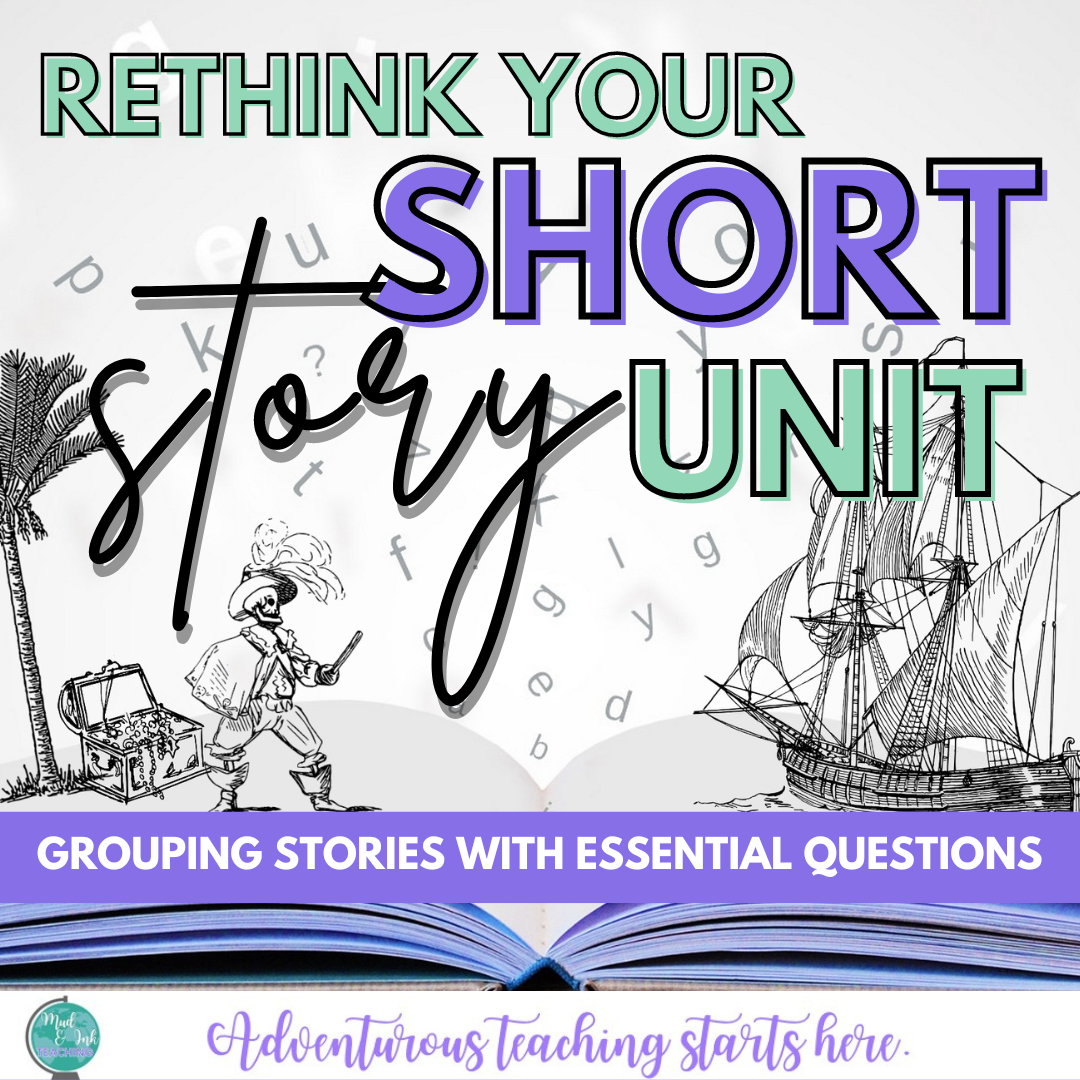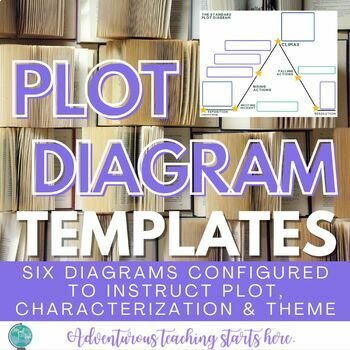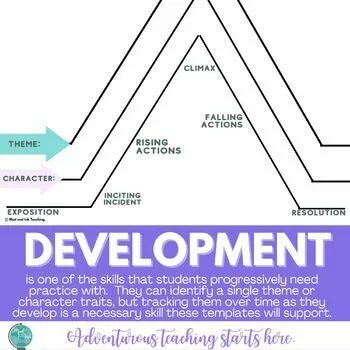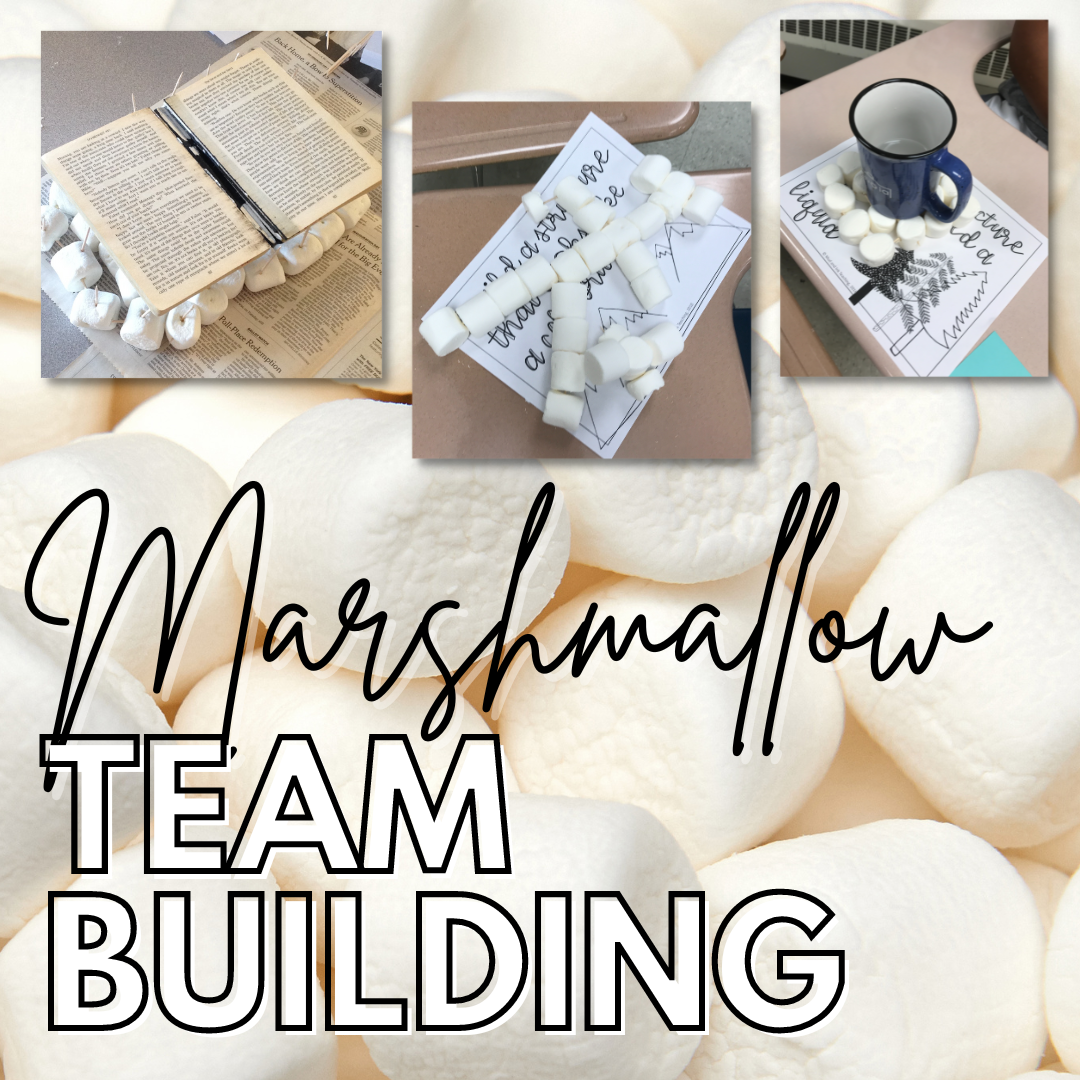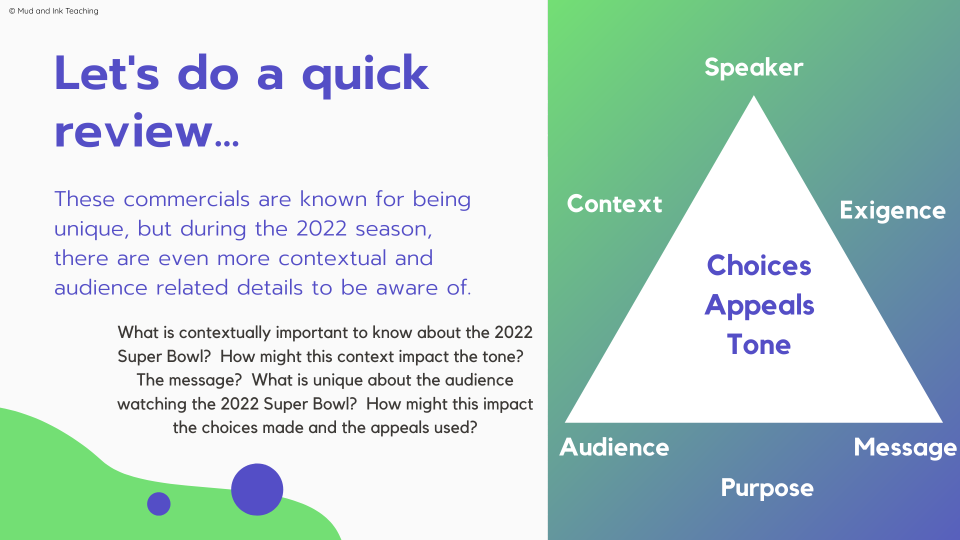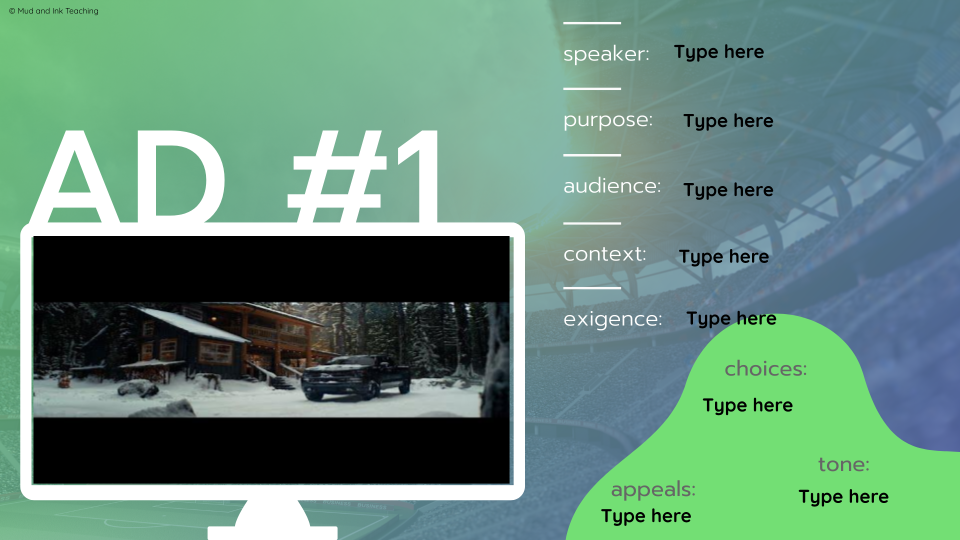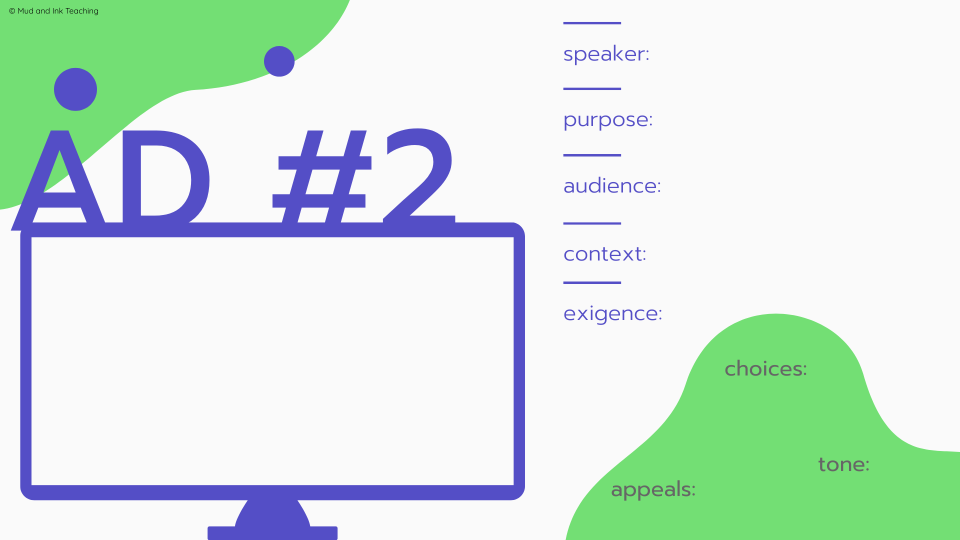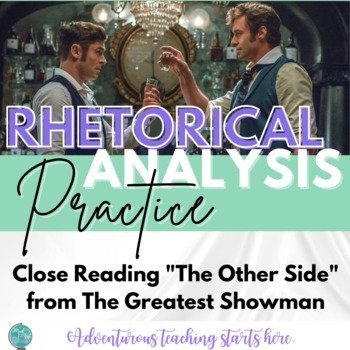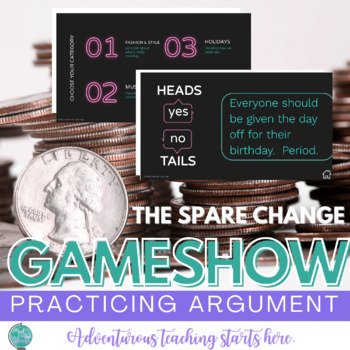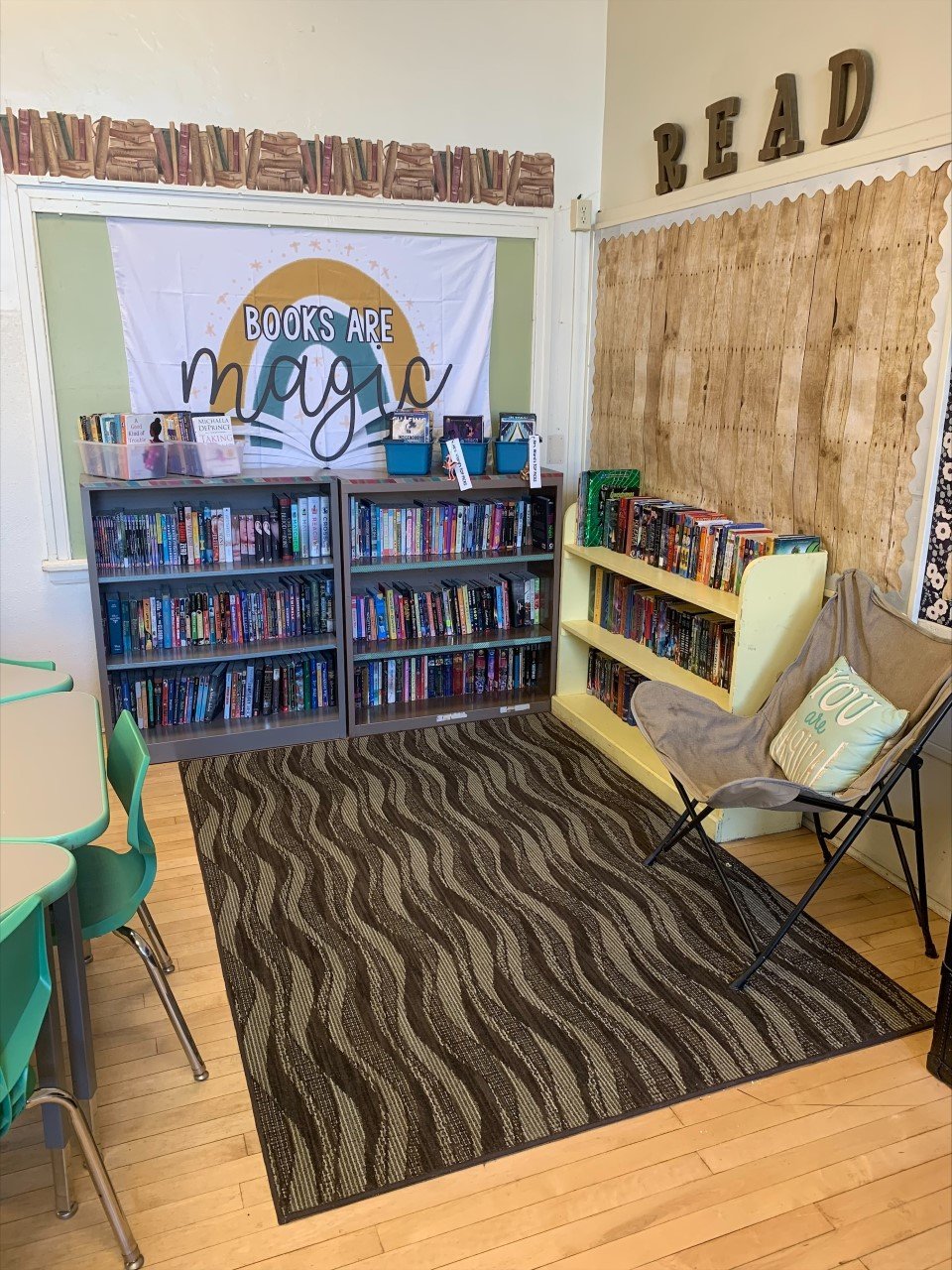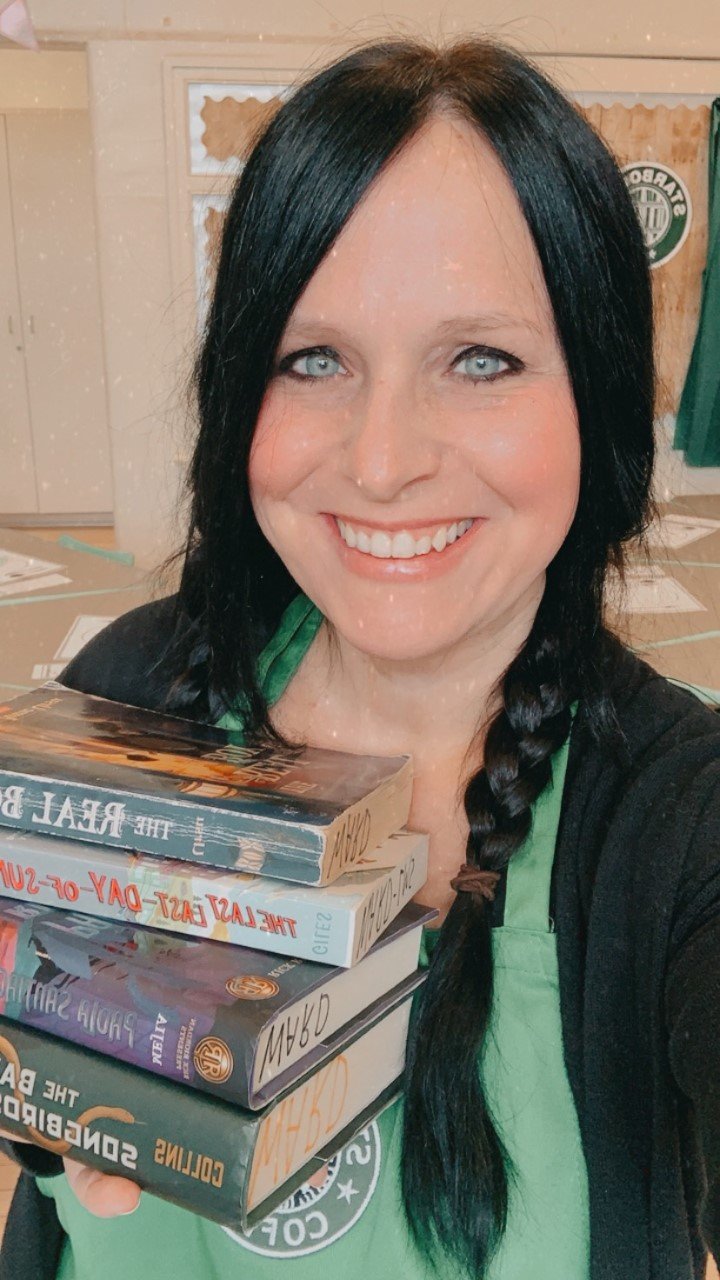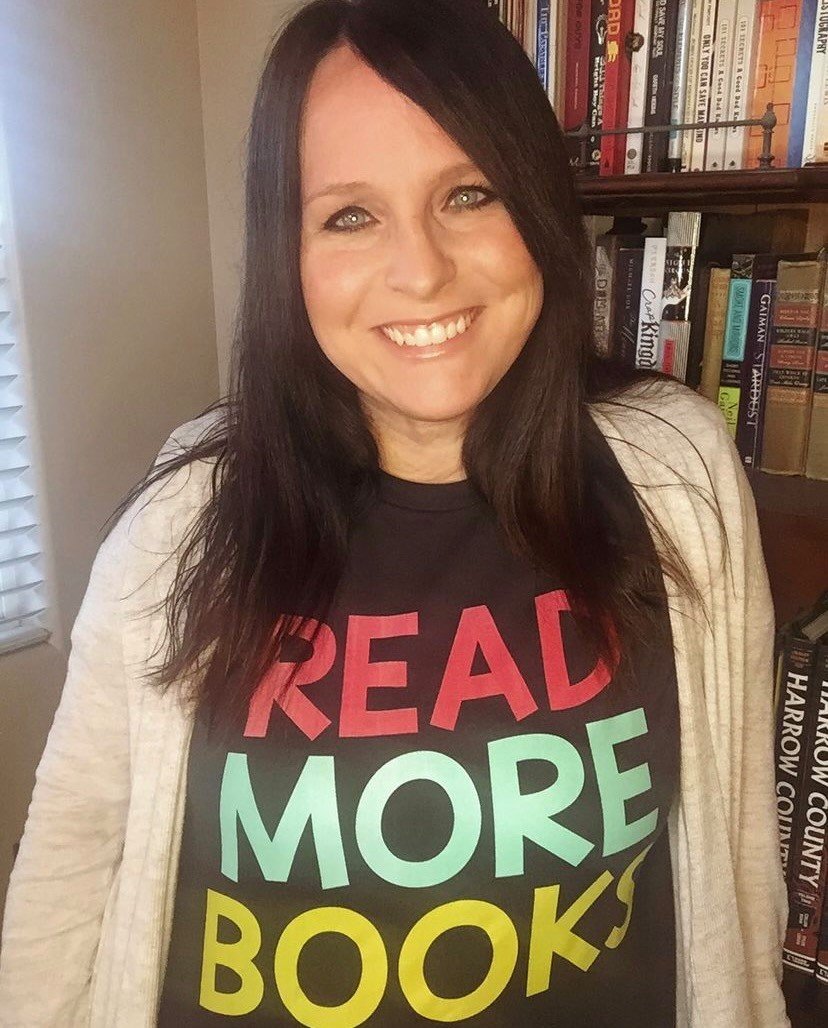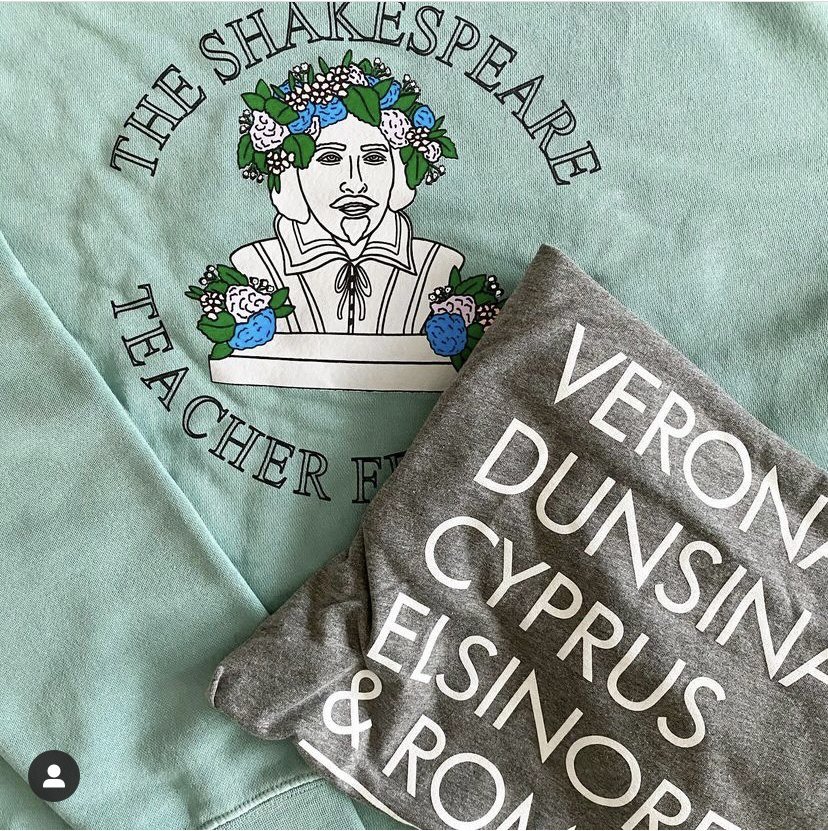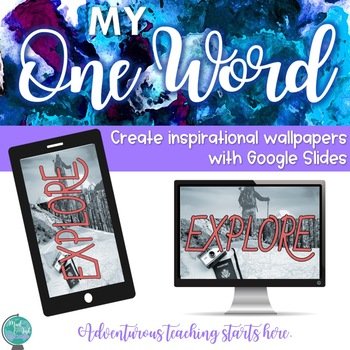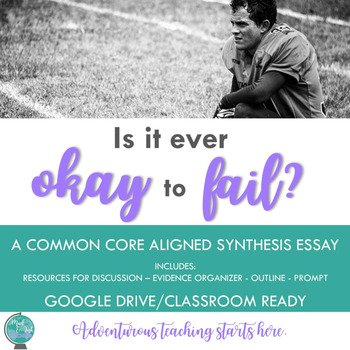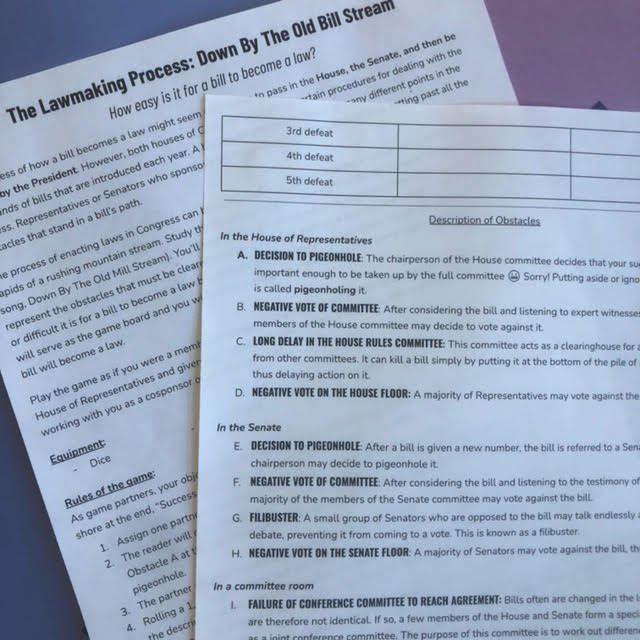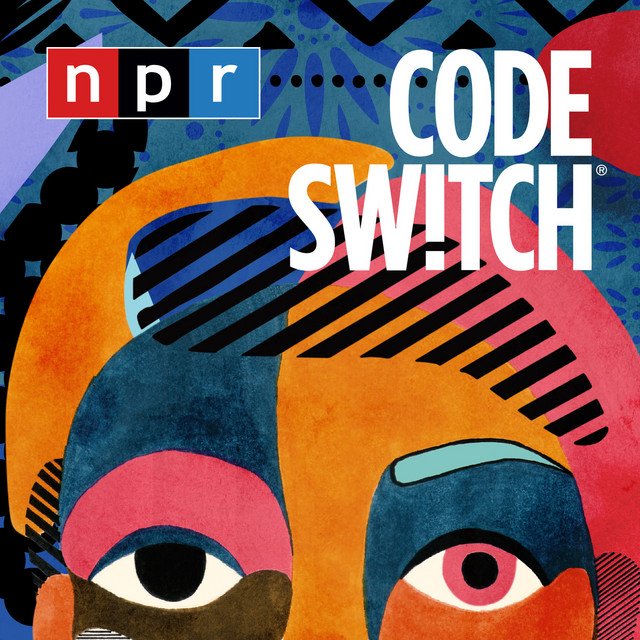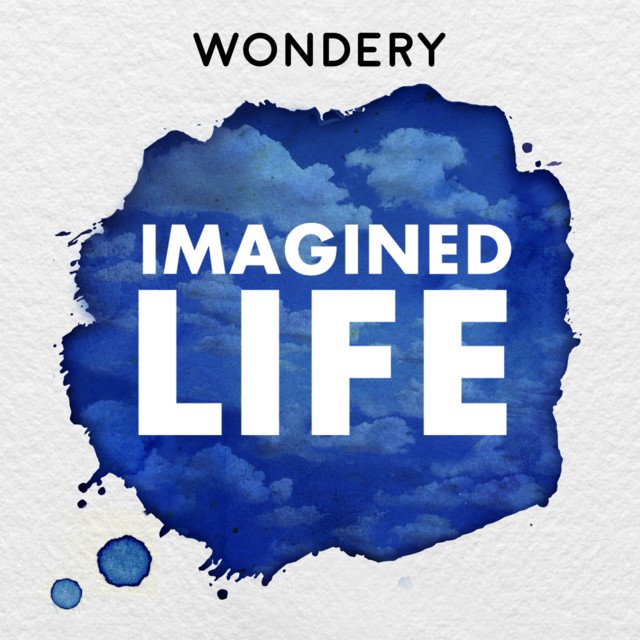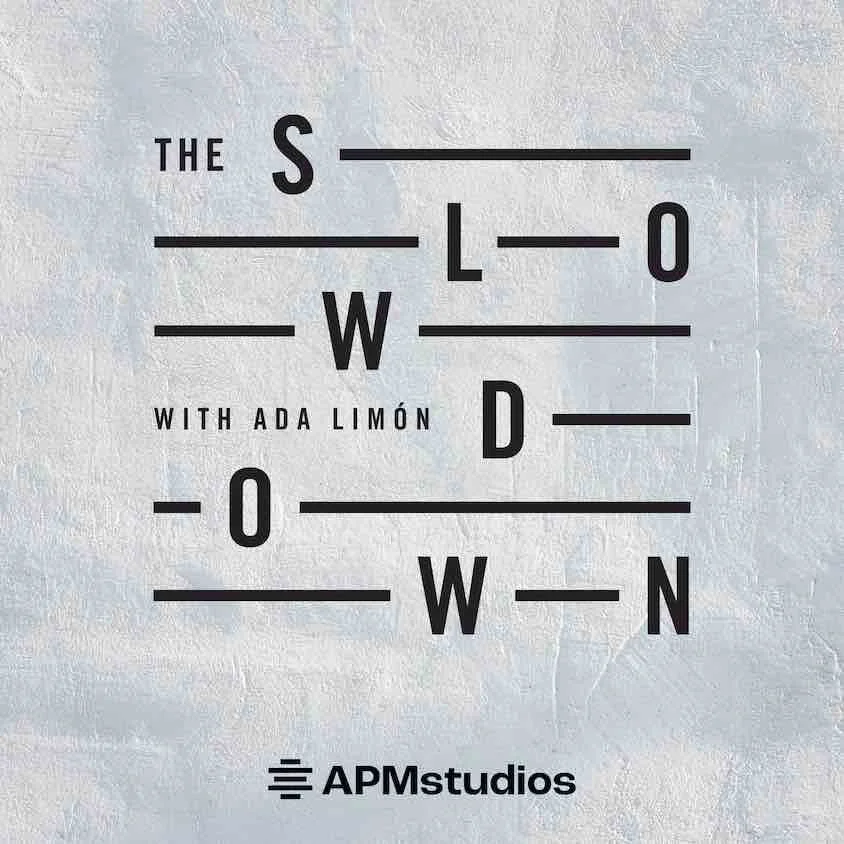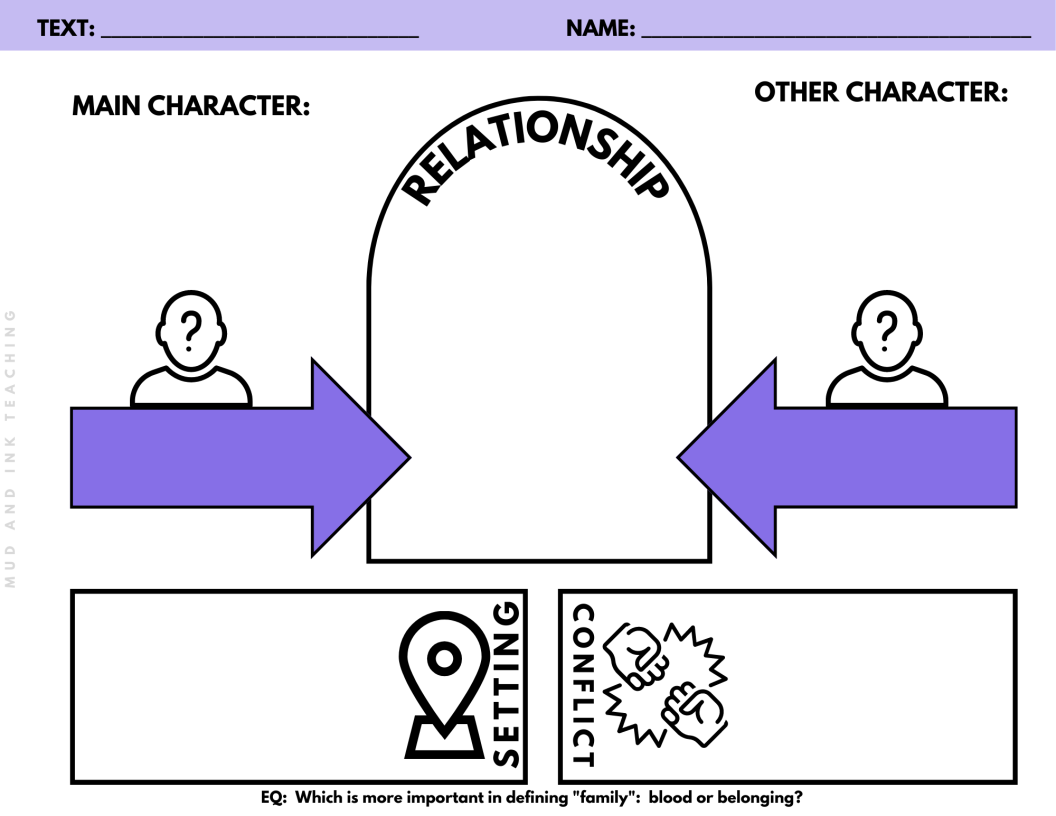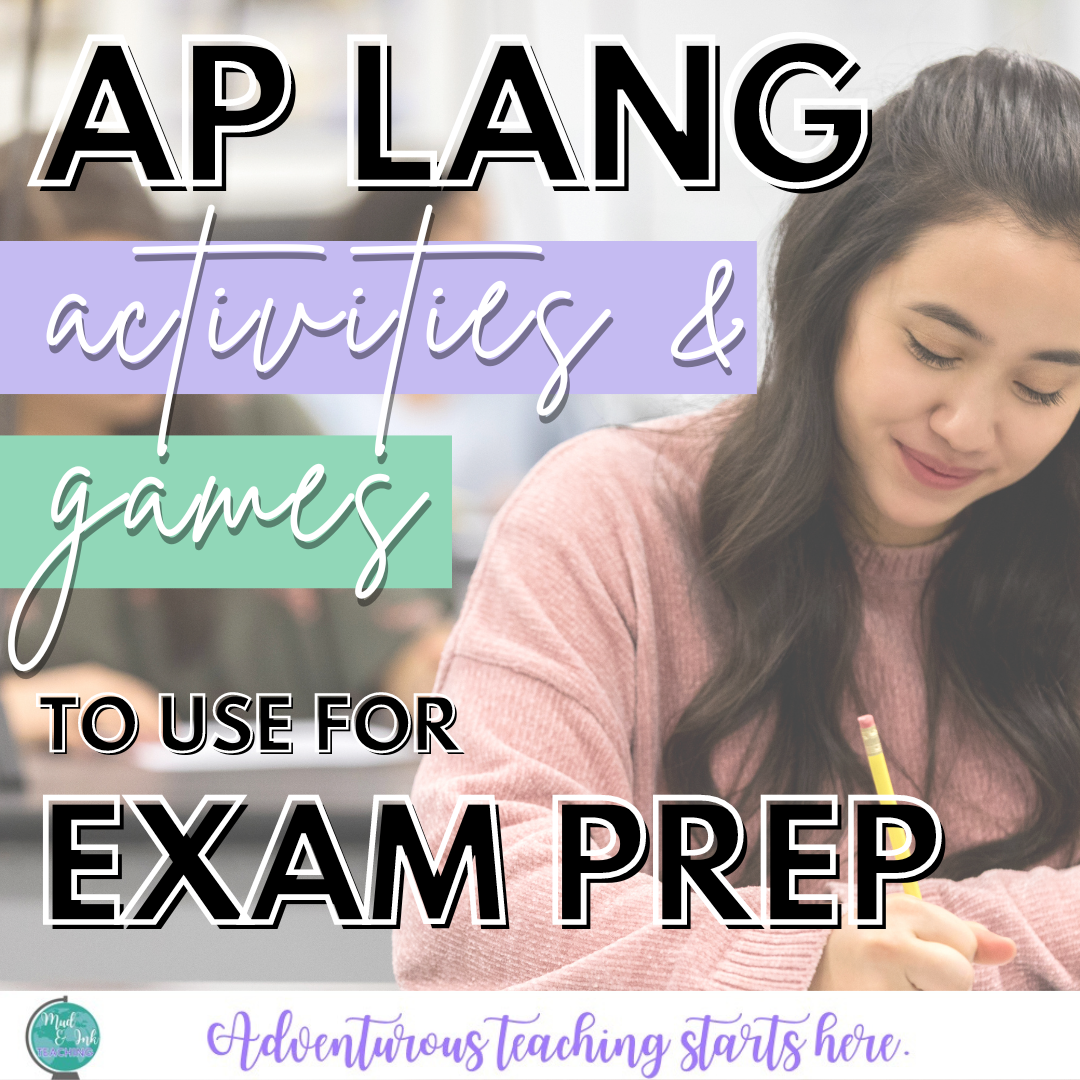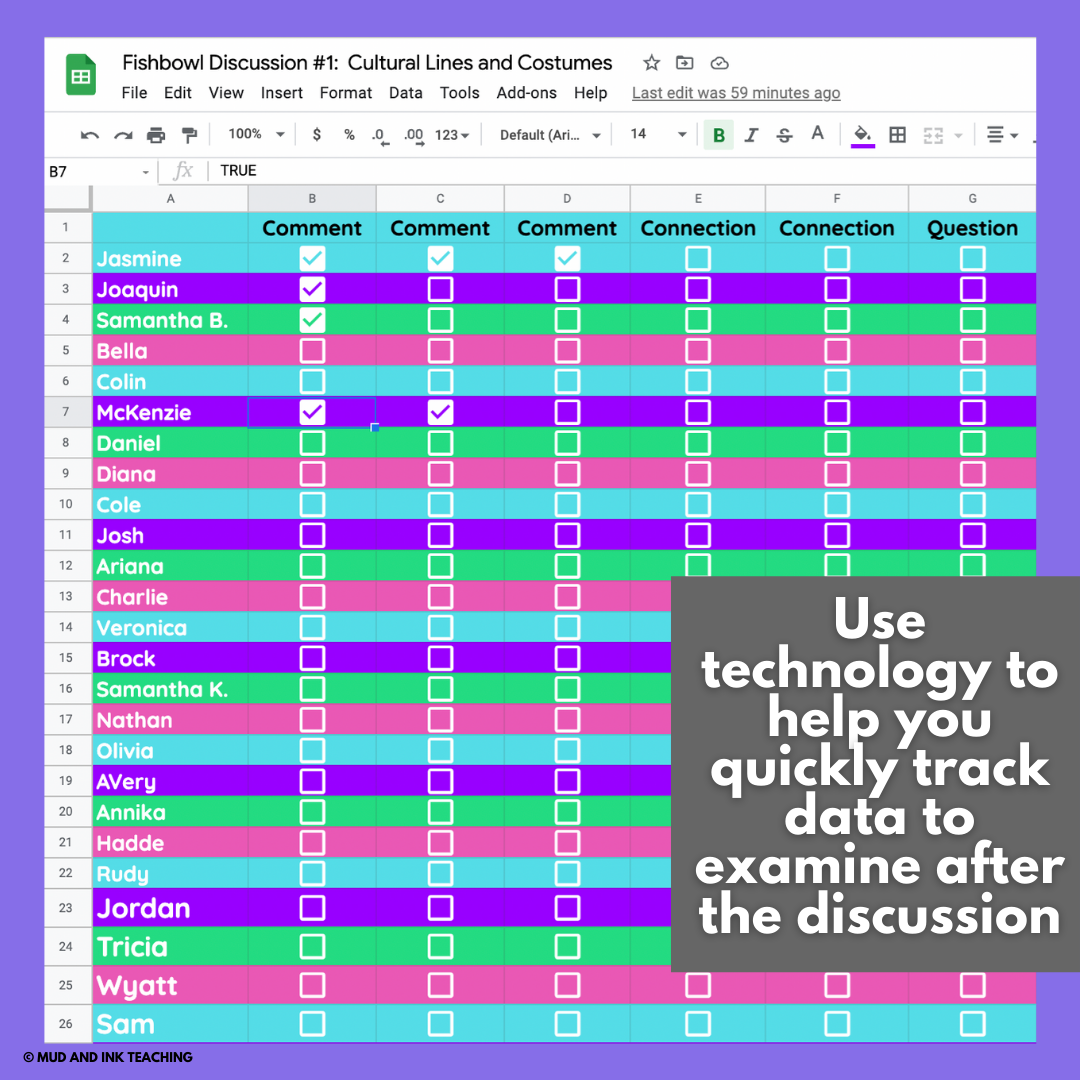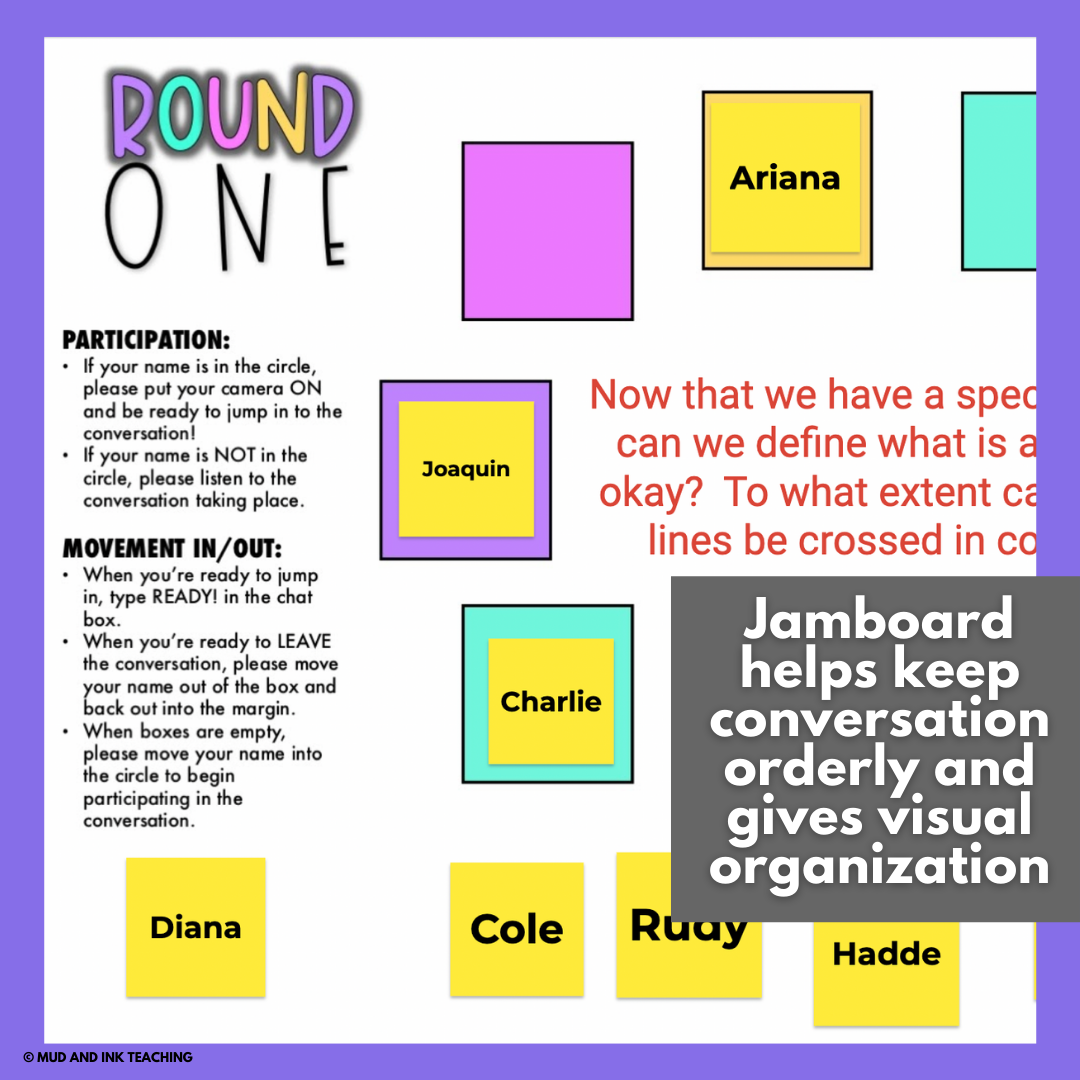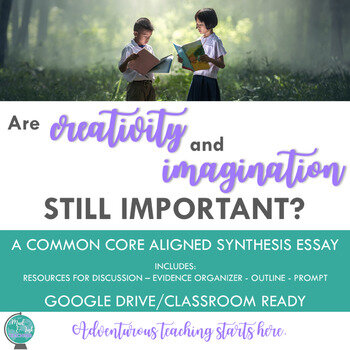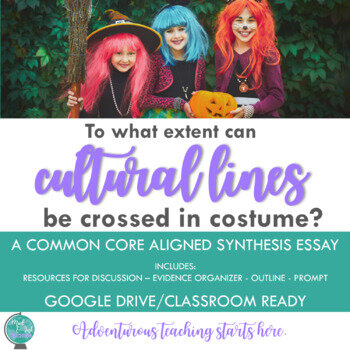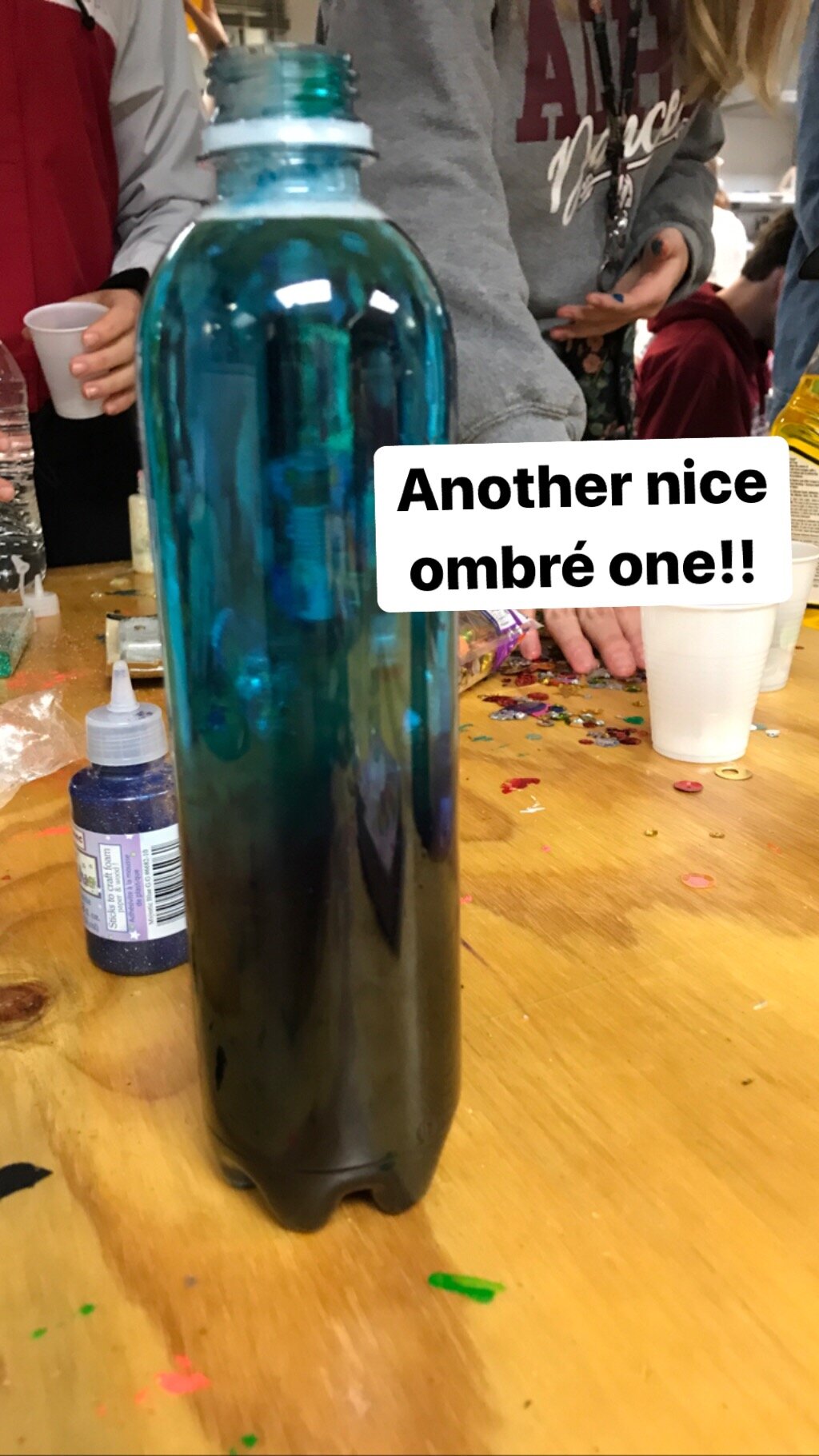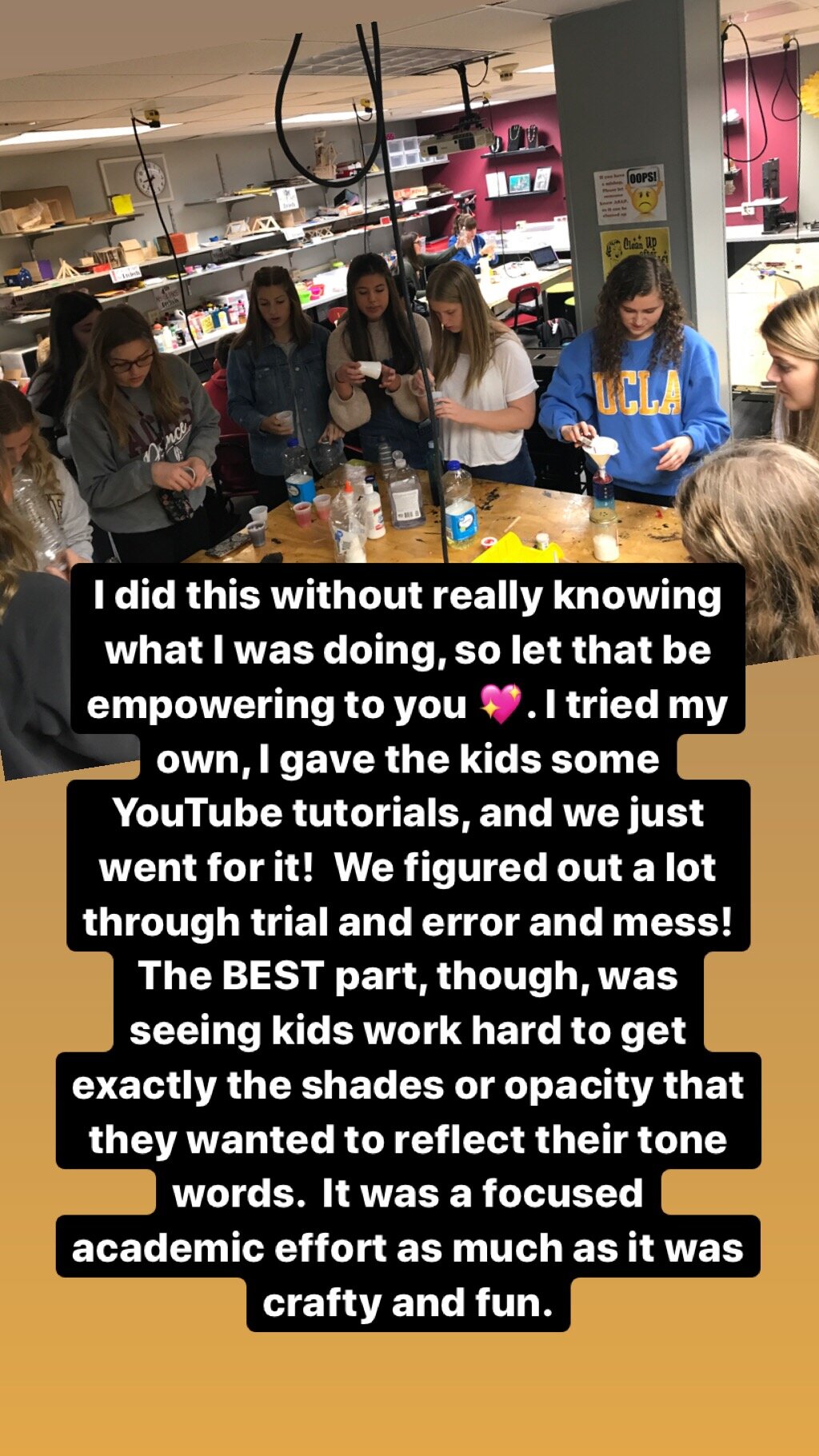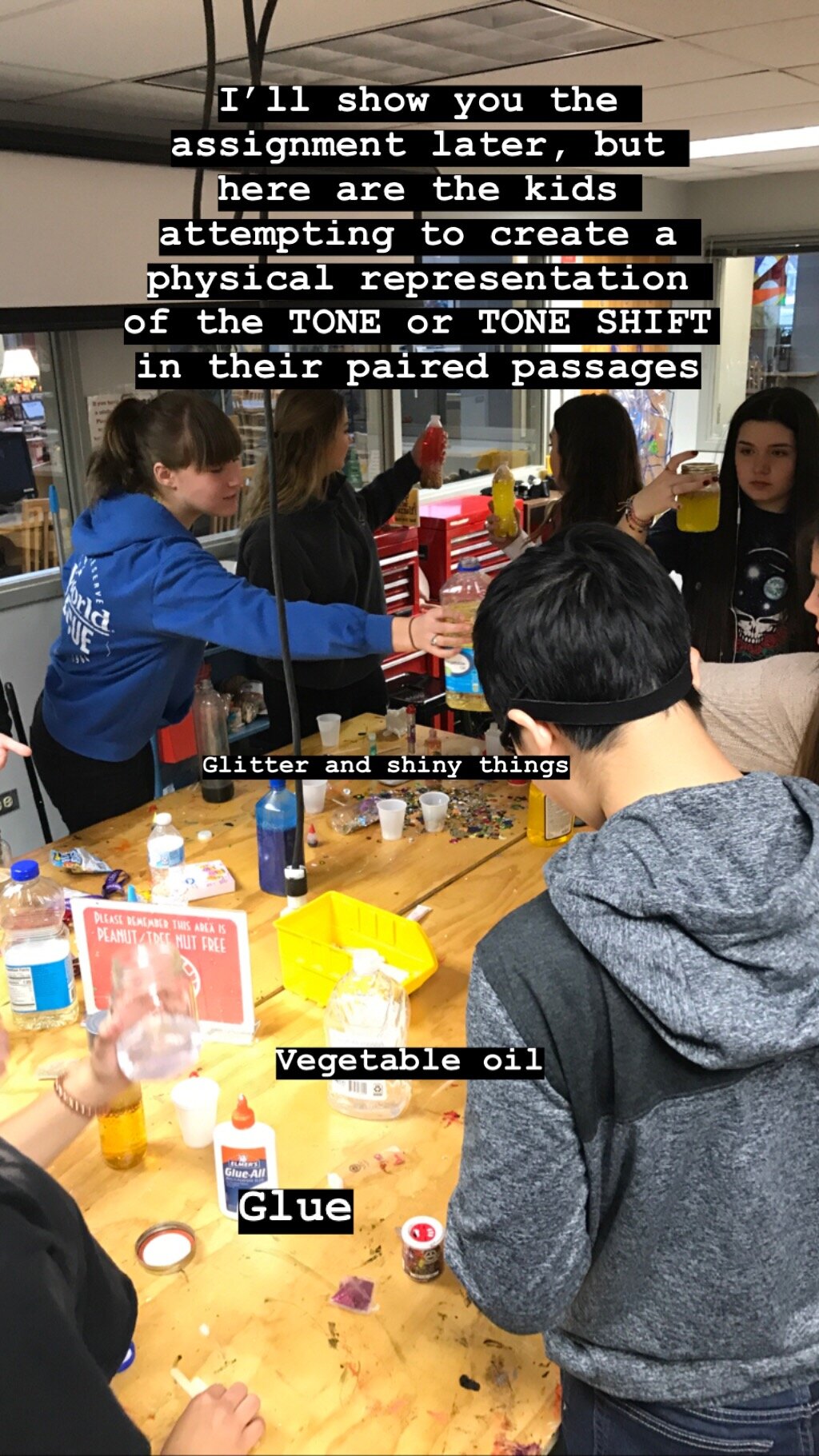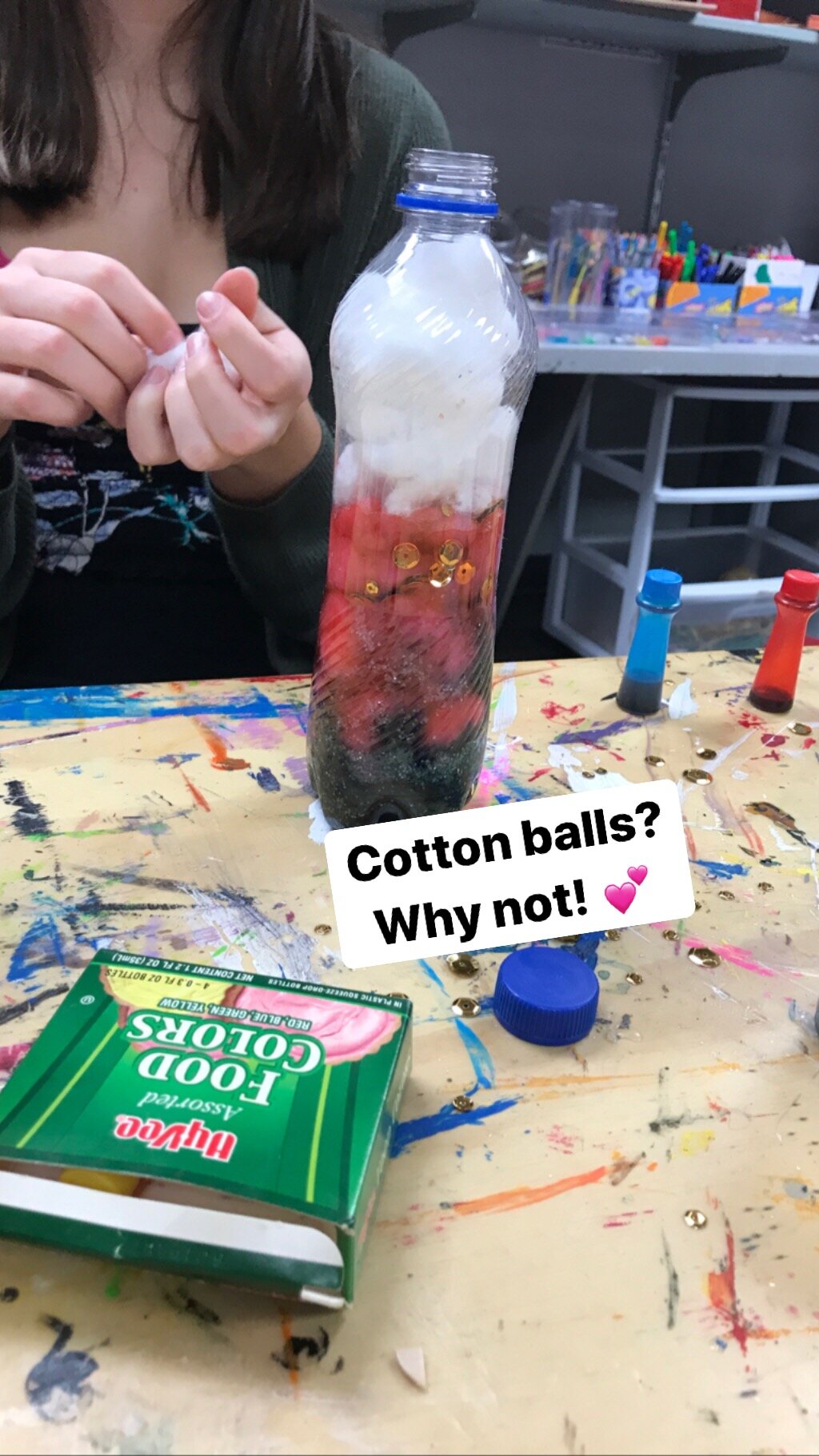
ADVENTUROUS TEACHING STARTS HERE.
Unit Makeover: The Short Story Unit in Secondary ELA
Short story units have the potential to deeply inspire and impact learning with students, but if the approach is disjointed or lacking any sort of alignment, these units can feel like flops. Here are the ways that I craft meaningful, engaging, and interesting units to highlight the short stories that we love (and a few more that we should add to the rotation!)
Unit Makeover: The Short Story Unit in Secondary ELA
When is the last time you sat down for a meal where your server recommended a very specific bottle of wine to match the meal you were considering on the menu? The perfect Argentinian Malbec to compliment the perfect marbled ribeye. And when is the last time you tasted that symphony of flavors? The melting, fatty salt of the meat on your tongue is followed by the gentle swirl of the deep red wine just after.
Maybe you’re a vegetarian and ready to never come back here and read another article from me again, and I understand (this is not the first time that I’ve used a metaphor about meat. Hmmm…), but if you’re willing to hear me out, here it is:
Disjointed experiences are fine, but intentionally, purposefully blended ones are so much more memorable.
This is precisely how I feel about unit planning and especially the notoriously predictable plan that every English teacher since the dawn of time seems to design: UNIT 1 - SHORT STORIES.
THE DISJOINTED SHORT STORY SCENARIO
The idea for this unit seems logical on paper: start the year with some shorter texts to warm back up, review everything students need to know for the year coming up, and presto! Ready to take on the year. But after experiencing this myself and talking to hundreds of other teachers, there are a few notable problems:
PROBLEM 1: Lack of connection
Short stories don’t naturally connect to one another just because they are short stories. So when we begin these units thinking about the skill review component, we are often blindsided as the unit is in progress feeling like it’s clunky and lacks flow. Without the feeling of connection, these units can be difficult to navigate in terms of pacing and engagement.
PROBLEM 2: Lack of representation
The most commonly anthologized stores also tend to be Euro-centric, male-authored stories. We have a responsibility to do better for our students and to have their own voices, stories, backgrounds, and experiences represented and included in everything we do. This means branching outside of the short stories most frequently recommended by text book companies and doing some of our own research to find new, fresh voices.
PROBLEM 3: Lack of variety
One teacher wrote to me saying: “I do run into trouble when I try to use short stories that are available on CommonLit. When I've tried to use them in the past--some are amazing short stories, like "The Landlady" and "The Intepolers"--the kids complain that they've already read them! UGH”
Does this sound familiar? Since starting the year this way is so popular and databases like CommonLit have come around, teachers sometimes find themselves going to the same places for ideas and then repeating stories.
PROBLEM 4: Trying to cover too many skills
Sometimes the nebulous goal of “reviewing literary terms” stretches student focus too thin. Attempting to use one single unit to cover a dozen or more terms ends up giving us more attention to breadth rather than depth.
Specific EQ Unit & Text Set Pairings:
To solve many of these problems with the traditional short story unit, I recommend implementing an Essential Question to drive the unit. Short stories need to be contextualized, and using an Essential Question connects the dots and creates meaning. The art of writing an essential question takes into consideration three key components: text(s), themes, and skills. Essential questions should drive genuine curiosity and be exciting for students to explore, discuss, debate, and return to throughout the year.
Below, I’ve drafted a few examples of EQs that could theoretically be used at the start of a school year. You’ll notice a few things:
The question anchors the unit. From introducing the question to assessment, the question is the driving force that connects all texts and activities.
Instead of teaching short stories and a variety of random literary terms, the unit is cohesively driven by a more narrow focus.
The EQ gives direction for the unit without being prescriptive. The suggestions I have here are flexible and adaptable to different grade and difficulty levels.
In each of the example units below, I’ve provided a mixture of the most commonly used short stories that you may have from anthologies or prescription curriculums blended with new ideas, short film, music, and other genres to further address the complexity of the EQ. Be sure to check out Episode 107 of the Brave New Teaching Podcast to see how this method was applied in Marie’s class!
Here are a few example ideas to get started:
Example #1: Connected by a skill/standard
Unit 1: Is conflict more likely to make our lives better or worse?
Skill Focus: The shape and arc of stories
Plot diagram components (with emphasis on conflict)
Exposition, inciting incident, rising actions, climax, falling actions, resolution
Vonnegut’s The Shape of Stories
Internal VS External Conflict
Three classical types of conflict: “man vs man”, “man vs. nature”, “man vs himself”
Text Set:
Buzz Lightyear Internal Conflict - You are Just a Toy: Scene 1 & Scene 2
All American on Netflix Episode 1
Assessment:
Skill Focus: Cold Read & Written response based on conflict
EQ Focus: Synthesis argument writing answering the EQ (utilize personal experience and texts from the unit to answer EQ)
Example #2: Connected by genre
Unit 1: To what extent does gothic fiction reveal the human condition?
Skill Focus: The elements of gothic fiction
Author’s use of tension
Author’s use of tone/mood
Setting
Text Set:
Excerpt from Mexican Gothic by Sylvia Moreno Garcia
Various scenes from The Phantom of the Opera
Assessment:
Skill Focus: A project-based assignment where students analyze the connection between tension, mood and setting (a recreated scene and written analysis; a living tableau; an artistic interpretation)
EQ Focus: A literary analysis writing that hones in on one of the stories and the gothic elements that reveal the human condition
Need to teach plot elements?
Example #3: Connected by another genre
Unit 1: How does dystopian fiction use the present to predict the dangers of the future?
Skill Focus: The elements of dystopian fiction
Characteristics of a dystopian protagonist
Author’s use of tone/mood
Setting
Imagery
Text Set:
“There Will Come Soft Rains” by Ray Bradbury
“The Lottery” by Shirley Jackson
“Harrison Bergeron” by Kurt Vonnegut
“The Ones Who Walk Away from Omelas” by Ursula K. LeGuin
Assessment:
Skill Focus: Cold Read & Write: How does the author’s use of genre elements / setting / imagery / use of tone/mood in order to warn about the dangers of the future?
EQ Focus: Research project: select a present problem and predict the dystopian future to come from this issue
Example #4: Connected by a theme
Unit 1: Which is more impactful in a child’s coming of age: the influence of family or the physical environment around them?
Skill Focus: Elements of coming of age genre
Setting
Characterization (direct & indirect)
Text Set:
Assessment:
Skill Focus: One Pager - Choose one character to place at the center. Surrounding the character, add evidence of coming-of-age moments, setting, etc. that have influenced their development
EQ Focus: Synthesis Argumentative essay responding to the EQ using the short stories from the unit
Example #5: Short Stories Reimagined in Fairy Tales
In episode 107 of the Brave New Teaching Podcast, I chat with my cohost Marie Morris about the process of tackling a unit makeover with short stories. Listen in to see how we resolved so many of the problems (at the top of this post) and built a Fairy Tale Unit that completely revamped the level of engagement while still tackling all of the skills that mattered the most.
No matter how you tackle your unit makeover, consider the power of that Essential Question to give the context your unit needs. I’d love to hear how you tackled your own makeover, so be sure to leave a comment below!
TRY AN EQ ADVENTURE PACK!
These units are packed up and ready to teach! They are seamlessly aligned with a juicy Essential Question, supplemental texts, and plenty of templates to use in tandem with whatever short stories or novels you have on hand. Check them out right here!
LET’S GO SHOPPING…
10 Back to School Learning Station Ideas for Middle and High School
One of the best ways to start your back to school lesson planning is with a stations activity. Gone are the days of reading the syllabus out loud, and right in front of us are the days of interactive, meaningful, and focused activities. Get your students started in groups and take them through an orientation to your room, your expectations, and the school year ahead. Here are 10 ideas to get you started.
10 Back to School Learning Station Ideas for Middle and High School
For several years now, teachers have joined the mission to intentionally create a first day and first week of school that are reflective of the kind of classroom culture and environment that they want to create for the whole school year. Gone are the days of reading the syllabus aloud to students and droning on for days at a time. And one of the most popular ideas that has grown to replace these teacher-centered practices is the use of back to school STATIONS. It’s been a cornerstone lesson in my First Ten Days of School practice for the last decade.
Stations as an instructional strategy is relatively straightforward. A certain number of tasks that take a similar amount of time to complete are predetermined by the teacher and become the “stations”. Then, students are broken up into the same number of groups as there are stations. Using a timer, students work at their assigned station for the allotted time, then with the timer, switch to the next station for the next task. This is a great way to begin the process of teaching your routines around this instructional strategy -- trust me, your October self will thank you for starting routine practice early and often!
With back to school season always having a slew of odd ball housekeeping tasks to accomplish, stations is a great way to keep the pace of class moving, get students out of their seats, and begin the process of getting to know each other based on the small group they’re moving.
Syllabus & Questions for My Teacher
After making the switch from a paper to a digital syllabus, I’ve been able to navigate getting the important information it includes in front of both students and parents. With a digital syllabus, I can “assign” looking through it the night before stations, and then, in this station, ask students to revisit the syllabus and on an index card, leave questions and comments for me at the station that I can answer FAQ style in upcoming days. You could also give the students at this station a syllabus “quiz” in the style of true/false or multiple choice.
A copy of my digital syllabus template is available inside my exclusive course for teachers: The First 10 Days: The Complete Back to School Toolkit.
Establish a “Brave Space”
Station time is also a wonderful opportunity to set up intentional experiences for students to see and participate in your classroom expectations. One simple, yet powerful, station idea is to use a section of your room close to a whiteboard (using my FAVE markers) or giant post-it, and write on the board BRAVE SPACE. Explain in the directions for students to write around the word with definitions and examples of what a “Brave Space” should look and feel like in the classroom. I make sure to take a picture of each class period’s answers to use later for debriefing and adding to my digital syllabus under my “Expectations” tab.
FAQ QR Code Classroom Management System
Another way to use your stations activity is to introduce your students to various functional spaces in your classroom and give them a chance to be oriented to how they work, I speak about this at length in episode 58 of the Brave New Teaching podcast as we discuss the importance of functional classroom decor. For me, one of the most important spaces in my room is my FAQ QR Station. This is the place in my room where students come to get their frequently asked questions answered…by a video, not by me. Because we can answer questions about late homework, going to the bathroom, and other policies for only so long before we want to pull our hair out, right? So instead of answering these questions again and again (in October and November, especially), the QR code does all the work for me! This is how I prioritize functional classroom design over splurging at the Target Dollar Spot all summer long..
All About Me Student Survey
At the start of the school year, there’s quite a bit of information that I want to know about my students. Some I want to learn through conversation, but much of it I want to have to refer back to as the year progresses and I see where students are finding strength and struggle. I designed an All About Me Student Survey using Google Forms that I’ve used for years and I use this station to give students time to fill it out rather than making it “homework”.
Student-Created Classroom Decor
Typically each year I try to make one of my stations artsy crafty. The quick little project is usually connected somehow to one or more of the following: my classroom theme, something bookish and Englishy, something connected to authors we’ll study, etc. I love doing these things, but don’t have a lot of original ideas of my own, so I scour the internet for ideas! Here are a few things I’ve done in the past that have been fun and great for a quick station:
Blackout poetry on a random dictionary page: cut into triangles and closepin them to twine for a classroom banner
Contributions to a door decoration
This wreath but with different clipart
A collaborative poster of different sorts
Six Word Memoir
These can be used ANY time of year, but at the beginning of the year, six word memoirs serve as a quick and easy way to get to know students AND see how their writing brains work. Narrowing down their life story to only six words offers powerful insight into how they see themselves and how they creatively and critically approach the writing process. Since the station time might be too short to fully think this out, you might ask for a draft at this station and revisit them for a final revision later in the week.
Create a name plate/Name voice recording
Learning student names is a paramount priority when beginning the school year, but also something that can be very boing for other students to watch us struggle through. Instead of going through the attendance roster every day trying to learn names, use a station to have students create name places and even record a sound bite of their accurate name pronunciation! I show you how to easily do this in this blog post. All you’ll need for the station is paper and markers for the name plate and a few chrome books with tabs open to Vocaroo.com.
Classroom Library Tour
If you are an ELA teacher, another classroom space that you most likely need to share with your students is your classroom library. If you have a system for checkout and returns, if you have a routine associated with first chapter Friday, or just generally want students to begin perusing teh books on your shelves, make this an exploratory station! My classroom library is on a rolling cart: it’s a rotating “best of the best” system and the majority of my books are housed on a database that students access through QR code. Using this as a station during back to school give students a chance to explore that without a time-consuming overview from me and puts the ownership and focus back on the students as they begin that exploration on their own.
Take What You Need Station
Another classroom space that matters to me in the classroom is my Take What You Need station. This is an area by the front of the room that houses all of the little odds and ends of things that students are always asking for: breath mints, hand lotion, dry shampoo, gold star stickers, and more. I keep some coloring pages for students who need time to unwind when they’re feeling stressed, blank note cars to write a hand-written note to a friend, and more rotating goodies as needed.
Goal Setting
Fresh starts with a new semester are the perfect time for students to do some serious and some light hearted goal setting. I like using these one-pager templates as a station where students can do fun goal setting and add to the page as the semester continues. I have them choose three sections that are together, record the date, and share the goal. They can illustrate them as they like! As we move through the year, we revisit this template and add more and reflect on the things written at earlier stages in the semester.
I hope this year, back to school learning stations hit the trifecta for you: establishing routines, building relationships, and setting the bar for rigor. I’d love to take you through my full first ten days of school in my course when you’re ready. I’ve got every lesson, the philosophy behind each step, and a digital drop down lesson planning calendar all inside just waiting for you! Take a peek inside right here…
Happy back to school, everyone!
5 Tips for Creating and Implementing a Successful Unit Plan in Secondary ELA
Unit planning can feel overwhelming, but this guest post provides practical, easy steps for getting started on any unit. Follow Samantha’s guidance as she demonstrates the ways in which she organizes her “The Crucible” unit here!
5 Tips for Creating and Implementing a Successful Unit Plan in Secondary ELA
The following post is a guest writer contribution from Samantha in Secondary.
Creating a successful unit plan in secondary English Language Arts can be a daunting task. How should you get started? How do you know what students should be learning? How can you tell that they’ve actually learned something? In this blog, I’ll give you 5 tips for creating your unit plan that will help you consider the way you think about the unit all the way through assessing students’ learning.
#1: Getting Started with Unit Planning
In order to create a successful unit in ELA, you have to first know what’s expected of you. Does your district require that specific texts be taught? How about certain standards? Expectations vary widely from district to district, so make sure you know what’s expected first before you begin your planning. For example, my district requires that all 11th graders read “The Crucible” by Arthur Miller, so I knew that I was going to need to teach it.
#2: Begin with the End in Mind
Now that you know what’s expected of you, think about what you want students to understand when they’ve completed the unit. Having a clear goal will help you stay on track. This can sometimes come from the standards or can even be the response to whichever unit frame you’ve chosen. (See the next step!) Getting really clear on the unit goal will help your unit run much more smoothly. With my unit on “The Crucible”, I knew I wanted students to see how literature can translate to real life and span generations. “The Crucible” is an enduring text with plenty of implications in our current society, so I wanted them to be able to see that.
#3: Figure Out the Frame
How do you want to frame your unit for you and your students? Finding a frame will help everyone understand the larger picture. Do you want to use a theme, a genre, a time period, or maybe even the text itself? One way I love to frame my unit is through a text set that speaks to the same theme. Amanda loves to use essential questions which is another great frame that can work, too. Successful teachers have lots of ways to frame their units that feel natural to them. You have to figure out what works for you. Maybe you don’t know yet, and that’s okay! Try a few different ways until one of them clicks.
Again, in regards to my unit on “The Crucible”, I went with a text set with the theme of literature reflecting real life. My text set included: the play itself, the film (starring Daniel Day-Lewis and Winona Ryder, of course), nonfiction texts on various topics related to different sections of the book (like cancel culture), the poem “Half-Hanged Mary” by Margaret Atwood, and snippets from this podcast that recommends modern reading outside of the play. Finding appropriate novel pairings can also help if you want to concurrently run a choice reading unit which I often do.
#4: Ditch the Reading Quizzes
Okay, I’m going to say it: reading quizzes might have a time and place in very specific and limited instances, but for the overwhelming majority of time, you can assess reading without a multiple choice quiz. (Really, you can!) Instead of reading quizzes, I almost exclusively use response to literature activities. I set up my unit with before, during, and after reading activities and I use this strategy with every text we read (even short stories!). I have found so much more success in making sure that my students are actively participating in the reading instead of just making them read and following it up with one multiple choice test. Try it out! I’m positive you’ll love the results. Here are some ideas:
For the before reading activities, we set context, activate prior knowledge, make predictions, develop questions, etc. These can be incredibly powerful activities to help students get ready to read.
During reading activities give students a more active role in their reading. These activities can include anything from doodle notetaking, close reading, and more. AdLit has an impressive list of ideas on their website as well.
When students are finished, it’s time for the after reading activities. These tend to be my favorite. There are tons of creative ways to assess learning that isn’t another quiz. Try a One Pager, Mood Board, or a Book Flay Lay for starters.
In my unit on “The Crucible”, students read about the puritans, examined various versions of the cover to make predictions, and researched the Salem Witch Trials. For each act, I rotate during reading activities. Sometimes students create charts based on a specific question (for instance, how is Abigail different from Elizabeth?), find relevant quotes to analyze, or make a virtual field trip based on places the characters might visit. After reading, I use a great song analysis activity where students create a soundtrack for a character or the text itself. It is one of my favorite units to teach. If you’re interested in checking out my pre-made unit, click here.
#5: Make it Relevant
Adding nonfiction to your text set is an invaluable way to hook your students. Showing them how the text reflects the real world helps them understand the value of literature. I always find that when I add nonfiction text, students gain a deeper appreciation of what they’re reading in class. I have a variety of print-and-go nonfiction text activities in my TPT shop that cover an array of topics. All of my nonfiction text activities follow my tried-and-true close reading process, so students can gain a deeper understanding of the topic. You can also find paired text sets created for you through websites like CommonLit which are completely free.
I hope this blog post has given you plenty to think about in terms of planning a rich unit and creating engaging response to literature activities to accompany it. For more great tips for your secondary ELA classroom, follow me on Instagram or find me at samanthainsecondary.com.
Happy teaching!
MEET OUR GUEST CONTRIBUTOR:
Hi there! My name is Samantha and I am on a mission to help secondary ELA teachers find the best books for their curriculum and classroom libraries. You can find tons of book recommendations and creative ways to implement the reading in your own classroom on my blog at Samantha in Secondary.
3 Habits for Happy, Powerful Teachers
Teachers can have happiness and power over their own lives, but it all starts with creating good habits. These are three habits that changed everything about my teaching career.
Teaching is HARD. These are three habits that helped me ease some of the pressure of the demands of teaching. As with all habits, they take practice and small steps. I hope these help you feel like a boss in the classroom!
HABIT ONE: PLAN YOUR GRADING DAYS
This one took me years to learn, but once it became habit, the stress of grading significantly changed in my life. In backwards planning, we know to start with the assessment and plan our calendar backwards from there. But here’s what I started doing: as soon as I knew what that assessment was going to be, I decided right there exactly how many days I would give myself to GRADE that assessment. I started building my grading days into my plan for the unit. This helped me in so many ways:
Grading wasn’t happening magically whenever I found a free plan period or weekend hour. Grading was happening in a set time frame. Grading “in bulk” was a massive time saver — the more of the same essay I read back to back the easier it was to detect patterns across my classes of struggles and successes, making the subsequent revision lesson that much easier to plan.
Grading wasn’t a panic before the end of a marking period. If I knew that a marking period ended on a Friday, I would have decided that I needed four days for grading. Knowing this, I planned the assessment for the Friday BEFORE the end of the marking period, rather than a closer date. This ensured that I had the days I needed to grade and also accommodated any students that required extended time or were absent.
If you’re looking for more grading tips and advice, I’ve got you covered! I did an entire podcast episode about this and you might just hear a little nugget of wisdom to help you on your journey. Give it a listen below!
HABIT TWO: START EVERY PLANNING MEETING WITH ASSESSMENT
Okay, I promise I know how tempting it is to plan the fun stuff. The intro week, the gateway activity…it’s all so exciting and probably the most engaging part of your unit to come. But it’s time to start a new habit — one you might have to very consciously force yourself to practice: start with the assessment. At every team meeting, every time you sit down to plan, check in with the assessment. Are you making progress toward that assessment? Have you introduced and practiced the rubric with students? Are the lessons you’re planning building the skills needed to perform on that assessment?
This is a big switch. I used to start my planning with impulses. With new ideas I found online. It was energizing at first, but after a while, we were scattered and all over the place with tons of ideas, but no direction. Making the little habit switch to focusing on the assessment is one of the best ways I’ve found to help me with decision fatigue. Was it an awesome idea that I found on Instagram? Sure, but does it help students prepare for the assessment? If the answer was yes, then green light! If not, then it goes in the save pile for another unit.
HABIT THREE: PERFECT YOUR MONDAY ROUTINE
The Sunday Scaries are real. The anxiety, pit-of-your-stomach pain of a Sunday night with no idea what’s coming for Monday absolutely destroys any chance at resting on the day that you actually need REST. Here’s the third and final habit that will change your teaching life: create and stick to a Monday routine.
For me? Monday is all about formative assessment. For the most part, students are almost always finishing an assigned reading for Monday. I like to assign reading in large chunks and include weekend time to get that reading done, so Mondays in my classroom are dedicated to formatively assessing that reading.
There are so many benefits to assessing on a Monday:
Kids are coming off of a weekend which is the most realistic time frame that they have to accomplish reading outside of school.
The energy level is usually pretty low, so forcing a discussion or something interactive is usually pretty hard. Taking a quiz matches their energy level on a Monday.
Attendance is usually better at the start of the week than at the end
Assessment at the start of the week gives me usable instructional information about students to use throughout the week.
All of these are massive benefits to building up the habit of keeping a consistent Monday routine. If Mondays are planned, you are RESTING on the weekend OR using your creative energy for other things. Panicked energy is usually wasted energy, so let’s conserve those sparks of inspiration when you have them to something productive!
I’d love to share more with you about my Monday plans, so when you have a chance, give this episode of the Brave New Teaching Podcast a listen:
If you’ve got your planning down but are still looking for a way to shake up the way you run those formative assessments, take a look at the Brave New Teaching FREE Masterclass: Down with the Reading Quiz! You’ll learn all about my favorite Monday formative: the Sesame Stree Quiz. I promise you’ll never look back!
LET’S GO SHOPPING!
Helping Students do Hard Things in ELA
Rigor is not the same thing as busy work. Pushing students and challenging students to do their best work and to excel past their wildest dreams takes concentration, planning, and intention. Here are 12 ways to support students as you challenge them every step of the way.
With every inch of my soul, I believe our students can do hard things.
But doing hard things is not the same as assigning hard things. It’s not the same as providing difficult instruction, then expecting straightforward or immediate results.
Raising the bar and increasing rigor in our classrooms must be coupled with purposeful, intentional scaffolding, compassion, a deep knowledge of our students’ lives and backgrounds, and effective teacher-tested strategies. This blog post features a round-up of TWELVE strategies to try that can both push students toward tackling hard things, but still support them and guide their way.
1. SESAME STREET QUIZZES
When we talk about having kids do hard things, we have to look in the mirror and take a hard look at our own assessment practices. Why is something hard? Is it hard because it requires a high level of critical thinking? Or is it hard because the design of the assessment is something students haven’t tried before? Is it hard because the assessment wasn’t truly created with backwards design and students are attempting a skill they haven’t had enough practice using?
When it comes to assessment, we want to challenge our students’ critical thinking, but we also want to make sure that the assessment is an accurate measurement of skill growth. In the masterclass Down With the Reading Quiz, my podcast partner Marie Morris and I break down three types of formative assessments that can be used over and over again to help students master skills. My personal favorite: THE SESAME STREET QUIZ.
It’s about as simple as it might sound: the quiz shows students four items, three of which are connected, and the other is an outlier (one of these things is not like the other!). In this podcast episode, we break down the philosophy behind using our Sesame Street quiz formative assessments as a regular practice in your classroom. I love that this quiz checks off many important boxes for me in terms of what matters in the classroom and asking students to do hard things:
They promote equity: this is a show me what you can do-type of assessment, not a “gotcha” quiz
They are rigorous, but can also be scaffolded
They can be graded on a rubric rather than using arbitrary points
They help kids understand that you care more about holistic interpretations of learning rather than minute details (unless the details provide commentary on the whole!)
Sesame street quizzes are a HARD THING to ask kids to do, but one that they can get really good at. With scaffolding, practice, and reinforcement, we really can ask our students to do hard things.
2. MAINTAINING EXPECTATIONS THROUGH STUDENT INTEREST
As winter starts to come to an end, many students start to become less enthusiastic about learning as spring nears. Sharena from The Humble Bird Teacher uses student interest to maintain high learning expectations in the classroom through project based learning. With project based learning, the students learn to think critically and solve real-life problems independently. Most importantly, the students are the captain of their education as they dive into topics that interest them and bring about discussion and collaboration and fun! In this situation the teacher becomes the passenger, or guide, who steers the students in the right direction. Project based learning can keep behavioral issues low and help with maintaining classroom expectations because when students enjoy learning, they are more likely going to invest in their education rather than not.
How can you implement this strategy in your own classroom?
Select project based learning assignments that align with district standards.
Pick three to four of them and give students a preview of each one.
Allow students to select the project that interests them. Some project based learning tasks require groups. In this case, have students vote as a class.
Let students get creative and solve the problem presented in the project! This is where the fun and learning begins!
Remember, you are the guide and not the captain. Provide your students with the support they need to be successful, but let them steer the ship. Do you want to learn more about project based learning? Sharena recommends the blog post Project Based Learning and Assessment.
3. ROUTINES THAT CREATE PREDICTABILITY
In order to maintain high expectations and provide support to get there, Samantha from Samantha in Secondary focuses on classroom routines to make sure students feel heard, respected, and supported. It might seem obvious to make sure your routines are intact, but as the year drags on, it can be difficult to maintain that high level of expectation when students are so comfortable in your room. Routines provide stability for your students so they know what to expect from you and your class. Being very explicit about your expectations and routines (even if you find that you’re repeating yourself multiple times) sets the benchmark for student achievement. Evaluating (and maybe resetting) just a few of your classroom routines can make all the difference. Here are just a few to consider.
Bellringers: How are you starting class? Is it chaos for the first few minutes when students come in? (No judgment—everyone has been there!) Provide a reliable structure that students can anticipate so that they understand how to be successful. Consider visual writing prompts or attendance questions as a routine to start. Giving students something to get them started immediately is an invaluable routine that will set students up for a strong class period.
Daily Agenda Slides: Are you being explicit about what’s being covered that day and allowing students to see how they can be successful? Make sure you have a daily agenda slide ready to go. (You can put your bellringer right on there as well—win, win!) Listing the activities for the day and the assessment can show your students immediately how they can be successful and allow them time to think about how they might need to be better supported.
Close Reading: Within your novel units - whether whole-class, book club/lit circle or choice – this powerful instructional strategy teaches students to read with intention and purpose, and it is best achieved as a regular, weekly practiced routine. Whether you are new to close reading or have tried and been frustrated with it, the Mastering Close Reading video (asynchronous) workshop series offers the guidance and support to build a strong routine and effective lessons.
Do Something Fun: You can do activities that are both fun AND academically aligned. Make sure you are showing your students that you care about them as people and students. Strengthening classroom culture only leads to students wanting to achieve more academically in your class. What can you plan today that will lead to stronger classroom culture tomorrow?
One of the things that makes teaching so difficult is the unpredictability of each day. Students need different things at different times and some of the things they need to be supported and successful are completely out of teachers’ hands. One way you can provide support for them to do hard things is to make sure your class is set up in a way that they know how they can succeed. Classroom routines are something you as the teacher can control that can make all the difference.
4. RUBRIC CONSISTENCY FOR GROWTH
Students need to know what the goal is if they are going to reach it, right? Krista from @whimsyandrigor knows this to be true, which is why she has created one rubric to rule them all. (Ok, technically there are two rubrics-one for creative writing and one for analytical writing, but you get the idea.) By this “Almighty Rubric”, she means she has created a single rubric that students use ALL year long, from August to May. This is how they know what to reach towards, how to grade themselves on their work, and how to see their progress throughout the whole year. Because students use the same rubric all year, they get to know (and love?) the criteria and, by the end of the year, basically recite each expectation.
At the beginning of the year, Krista knows that students are going to be below expectations on a few of the traits (maybe their command of a comma is still in development or their ability to explain evidence is at the beginning stages), which is why she only grades students on specific aspects (maybe the intro and the use of topic sentences) and not on every single area, until she actually teaches all of the traits on the rubric. However, she does mark the students’ standings on all of the traits so they can see where they currently stand and know precisely in what areas they can grow. As their skills progress and the units introduce each of the traits on the rubric, Krista slowly starts grading more and more.
Speaking of knowing where to grow, built into each rubric is a reflection piece that asks students to reflect on what they did well and what they can improve for the next assignment. This habit of getting students to reflect on both their strengths and weaknesses is one that will serve them well as a student who truly owns their learning.
So, if you have ever wanted to help students see their goal, monitor their own progress, and not have to create a million rubrics, this might just be the solution for you. Click here to check it out and see if this is a resource that would benefit you and your writers!
5. PROVIDING STAGES FOR LARGER PROJECTS
Molly at The Littlest Teacher found that students were often overwhelmed by major projects, such as the research paper. Big projects are hard-but-valuable experiences for students because they challenge students in the areas of organization, time management, planning ahead, growth mindset, and more.
To provide support while still maintaining her high expectations, Molly turned to heavily detailed scheduling and communication.
The most important way to support students during a big project is by breaking down that project into many smaller steps for students. They need to know much more than “What do we do, and when is it due?”
With a traditional research paper, for example, Molly would break it down into mini milestones, each with their own due date, such as: topic selected by March 5; brainstorm completed by March 6; 5 sources collected by March 9; 20 notes recorded by March 14; etc.
Along with the task and its due date, Molly also included the page number of students’ writing textbook where examples and information for each step could be found. If you’re not using a textbook, consider providing links to videos or webpages that give examples for each step of your project.
Molly compiled all of this information onto a neatly organized and easy-to-read handout that she provided at the beginning of the research project. She put a paper copy of the handout in students’ hands, posted a copy on Google Classroom, and even emailed a copy to parents, along with a brief explanation of the goals of the project.
Building in all these little checkpoints throughout the project helped Molly stay on top of where her students were at in the process, if they were understanding the project and moving toward success, and allowed her to see where students were veering off course from expectations and gave her the opportunity to correct struggles before students got too far into the project.
What’s more, providing so much detailed information about the project gave parents a tool to support their students through the process. This was especially important for struggling students.
When assigning any project that requires multiple steps, taking the time to break down all the details of the project and schedule out checkpoints for students and provide them with a calendar of the checkpoints will simplify the process for both you and your students.
6. ACADEMIC ART THERAPY
Infertility and postpartum depression had left Olivia in a dark place. As she began her healing process, she realized how many of her students were also struggling. She began to prioritize her students’ emotional health, starting with a concept called academic art therapy. Here are a few of her ideas:
When studying Literary Mood, have students illustrate each mood with colors and symbols. This helps students become more aware of their own emotions—and it helps them recognize mood in their reading, too.
Before analyzing a story’s plot, lead your students in a body scan. They can close their eyes if they are comfortable and then pay attention to which parts of their bodies feel relaxed and which parts are experiencing tension. Have them draw a body silhouette (or give them a pre-made template) and encourage them to color in the body with colors that represent how they feel. When you’re ready to discuss a plot diagram, encourage your students to analyze the stress or tension in each part of the story to determine the climax of the plot. Be sure to refer often to the body scan and art therapy as you go!
Have students trace their hands, then fill one hand with illustrations of their past and one with illustrations of their future. When they finish, have them trace their hands again, but this time have them fill one handprint with quotes about a character’s past and the other with predictions about the character’s future.
7. KEEP PARENTS CONNECTED
Supporting students and maintaining expectations sometimes means talking to parents. Parent communication doesn’t have to be anxiety-inducing. Yaddy from Yaddy’s Room makes sure students’ parents and guardians are tracking what happens in the classroom in an effort to maintain expectations. Whether it's to brag to parents that their child wrote a phenomenal intro paragraph that she threw up on the board for other students to examine or its to let a grown up know that their student needs a pep talk on appropriate school behavior.
Parent communication is the foundation of classroom management and the key to reducing nerves when you need to have not-so-pleasant conversations about student behavior or academics. She's found that creating relationships with parents through email and phone calls at the beginning of the year helps to create a dynamic where parents feel they are partners with teachers in their child's education and behavior.
To make parent communication as painless as possible, Yaddy makes sure to follow the following steps to make every communication a painless one. First, she introduces herself as an ally to student success in an email to all student parents with a highlight of engaging activities she will facilitate for students. Then, she makes sure every follow-up email highlights a student’s positive behavior or performance, and then she dives into whatever the objective of the email is. She finishes all parent communication with an invitation to schedule a phone call to address concerns. If you want to see how she does it, you can check out this blog post or download her email templates here.
8. UTILIZE CHOICE BOARDS
Katie from Mochas and Markbooks knows that when it comes to maintaining expectations while offering support, choice boards are just the ticket!
Choice boards provide a system for students to demonstrate understanding of specific curriculum in a variety of ways depending on ability level, interests, learning styles, and so much more!
Essentially, a choice board is a handout or digital slide with a table of boxes offering different options for a task. By offering different choices, students feel empowered and take more ownership of their chosen tasks.
You can direct your students to complete a specific number of options on the choice board, or you can create a Tic-Tac-Toe board where students must complete three tasks in a line, ensuring they hit on specific skills that you have strategically placed. For example, each line in any direction contains a written, verbal and visual option. To check out an example of this type of choice board, click here for a fun freebie!
Here are some ideas of how to use Choice Boards in your ELA class:
Pre-Reading Activity Options
Post Reading Assessment Options
Novel Study Project Options
Bell-Ringer Tasks
Early Finisher Tasks
Themed Choice Boards for Specific Holiday Activities
Poetry choice boards organized by themes or types of poetry
Independent Reading (links to readings and/or after reading response prompts)
The options are really endless - just like a choice board!
9. PROVIDE OPPORTUNITIES FOR REFLECTION
Doing hard things starts by putting together a game plan. The game plan for learning is understanding how you learn. Do your students have the attitude that school is happening to them? That learning is a chore they have no say in? Carolyn from Middle School Café has noticed after a year of online learning that many of her students have forgotten how to reflect on their own learning? They are not really sure how they learn, which makes creating their game plan to do the hard task of learning a difficult one to create.
Reflection is a life skill, not just an academic skill. As adults, we learn, process, reflect and adjust every day. To help students learn how to reflect, Carolyn has created these reflection sheets to help students think about their own learning.
By intentionally adding reflection time into her units and lessons, Carolyn’s students have begun to understand how they learn. Each day, Carolyn asks a combination of these 5 questions:
What did I learn? (Academic concepts)
What did I do? (What activities did I do that helped me learn?)
Why was it important? (How did the activities help me learn?)
How well did I do? (Did these activities help me to learn?)
What can I take away from this? (What did I learn about my learning?)
At first students will struggle with identifying how the activities help them learn, however, the more students are given opportunities to make connections between what they are learning and the process in which they learned, the more they will see the role they play in their own education – and stop thinking of education as something that happens to them!
USE INFORMAL CHECK-INS: DURING CLASS, DIGITALLY, & MONTHLY
10. STOP-START-CONTINUE CHECK-IN
Lesa from SmithTeaches9to12 incorporates student voice using a stop-start-continue check in that can be adapted in different ways. At midterm the check-in works for adjustments in how things are being taught to better suit the learners in the class. But it can also be adapted for students to reflect on work habits and behavior. For example, stop procrastinating-start asking for clarification earlier-continue being on time for every class. This can work as an individual element and then as a whole class too. It can help to re-establish class expectations and also opens up dialogue with students to spot those in need of more specific support.
To make this happen, give students three sticky-notes in different colors (eg. stop is pink, start is green, and continue is yellow). This also makes it easy for teacher review. For whole class input, add in big paper labeled with the three elements and have students place their sticky notes (anonymous works best) or simply wander and build directly on the paper. Students can review what others have written so they can expand their own reflection/feedback.
To learn more about supporting students’ needs in your classroom check out this post.
11. USE MONTHLY CHECK-IN SURVEYS
In the hustle and bustle of the tightrope balance that is teaching, it’s easy to forget that the most important thing is the kids. And that they are just kids. Simply Ana P is a huge advocate of relationships over content, and while content, rigor, and high expectations are all necessary, SEL focused activities, like check ins, are equally as vital.
Monthly student surveys are a fantastic way to check for student thoughts/ideas academically speaking, but also a way to check in mentally and emotionally. Life is really hard: heartbreak, trauma, grief, mental health issues, the endings of so many things, etc. - and for youth, they feel things twice fold, or sometimes more, and a lot of times struggle with or simply don’t know how to process or cope.
It can be really intimidating for a student to go up to a teacher and vent or ask for help. Check In Surveys are not a replacement for guidance counselors or the end all be all solutions, but they can serve an outlet for kids and as invaluable insight for teachers.
Ana assigns monthly student surveys at the end of every 3 or 4 weeks and then uses the input to guide her monthly one-on-one conferences with students over the following week. It’s significant for students to know that their teacher not only reads their input, but actively cares to discuss it and/or reply to it.
You can grab one of her surveys HERE - it is completely editable on Google Forms, so feel free to trash or treasure what you’d like. She hopes it can at least serve as inspiration for your next convo with a kiddo. Don’t forget to check in with yourself, too!
***Click this link for extra Google Form survey headers :)
12. DIGITAL CHECK-INS
When was the last time you checked in on your students? Check-ins and conferences can make all the difference in supporting students throughout the school year. Staci from Donut Lovin’ Teacher uses digital check-ins to gain a pulse on student wellbeing, interest, and overall level of comfort in class. These short and ongoing check-ins can help you with seating charts, grouping, and general knowledge about students’ lives. You can quickly whip up a Google Form using some of the questions below.
Try scaled questions (on a scale of 1 to 5) such as:
I feel cared for by my teacher in this class.
I feel cared for by other scholars in this class.
I put in my best effort on a regular basis while in this class.
I can work well with others around me in my current seat.
I am able to see the board well from my current seat.
Try open ended questions such as:
What is one thing going well for you in this class right now?
What is one thing that is challenging for you right now?
Who is one person you would like to give a shout out to in this class? Why?
What are we learning about right now?
What would help you to feel more supported in this class?
What’s one thing that has brought you joy lately?
Another tool to guide your work with students might be through Accountability and Support conferences where students reflect on their learning, behaviors, and growth. This allows teachers to work together with a student to make a plan for continued growth with new support in place. They were originally designed for virtual conferences, but work just as great for in-person conferencing too!
Lastly, If you haven’t tried out Student-Led Conferences yet, they can be a vital tool in connecting and supporting students and the adults that support them! They definitely take a lot of planning in advance, but it isn’t too late to start! You can read more about Student-Led Conferences in Staci’s blog post here.
I’d love to hear about how you are challenging students in your classroom, asking them to do hard things, and providing the needed support along the way. Leave me a comment below!
LET’S GO SHOPPING…
3 Super Bowl Ads to Analyze for Rhetorical Analysis
Rhetorical analysis is a skill that needs practice and reinforcement all year long. Take a break from what you’re doing and tackle these Super Bowl ads together for students to practice discussion and analysis in an entertaining and engaging lesson.
Note to readers: This post was written prior to the 2022 Super Bowl in an effort to help teachers pre-plan their lessons and not have to wait until the Sunday night after the game. The ads suggested in this posted are based on the year 2022 and what was pre-released ahead of the game. There are dozens MORE commercials to use as powerful teaching tools, and you can access our public Wakelet for more ideas here! Happy reading!
Rhetorical analysis is a skill that needs to be practiced over and over and over again. Too often, we are introducing ethos, pathos, and logos on repeat without ever getting much further. We know rhetorical analysis is so much bigger than labeling a few appeals: it’s about understanding the power of the message in the context that it’s delivered.
START WITH THE RHETORICAL SITUATION
If you are new to the idea of the rhetorical situation, fear not! I have you covered. For a basic overview for yourself AND a lesson for your students, I highly recommend checking out the article I wrote that shares the lesson I do with my students on the song “Be Our Guest” from Beauty and the BeastI. Go check it out here:
When it comes to Super Bowl ads, the rhetorical situation is just as important as figuring out what rhetorical strategies are in play. Students need help identifying the speaker (is it the company or the actor?), recognizing the different purposes of advertising on this specific day (hint: it’s not always to sell!), and getting a stronger grasp on the intended audience (students think they are the audience just because they are watching the ad. Think again, kids!). Students may have never considered the value (yes, I mean $$) of building brand loyalty or the cultural relevance of patriotic imagery.
Super Bowl ads taught in a group give us the instructional power to discuss context in a powerful way: these ads are so highly reflective of the climate of the country at the time, and this provides a powerful place to discuss the themes and trends that students are seeing in the ads. For example, Stacy Jones from Hollywood Branded predicts, “Some of the overarching themes to Super Bowl ads this year are going to be adventure, growth and pushing yourself to expand past your boundaries. We’ve been in a lockdown for two years, with people busting at the seams to get out and experience life and live. Brands and the people behind them feel the same—and they’re ready to help fuel the adventure.” These are prime conversations to have with students — and ones that will be highly engaging for them.
HYUNDAI: JASON BATEMAN ACROSS HISTORY
Up first is a car commercial: The Hyundai Ion 5, an electric car that promises to be a necessary advancement in the evolution of driving. Here are a few places that are worth spending time in your lesson and analysis practice:
SPEAKER: If we say that the speaker here is Jason Bateman, then we have an interesting conversation ahead. What is he known for? What types of shows and films is he in? Why would Hyundai choose him as their spokesperson? What credibility might he add to their brand?
AUDIENCE: Now that we know more about the speaker, what does that tell us about the intended audience? What kind of an audience would connect with Bateman? What kind of audience might be interested in this product? Think about: age, gender, social/economic status. Are those people likely to be watching the Super Bowl?
TECHNIQUE: ANAPHORA: The commercial uses a repeated phrase (anaphora) for each example of ways that we have evolved in our technology across history. This is a great opportunity to talk about the effectiveness of its use and how that connects to the overall purpose of the ad.
AT&T: ZAC EFRON FISHING
SPEAKER: If we say that the speaker here is Zac Efron (both speakers, actually), how does that affect our analysis? What is he known for? What types of shows and films is he in? Why would AT&T choose him as their spokesperson? What credibility might he add to their brand? Why might they have him dressed this way and out in nature?
AUDIENCE: Now that we know more about the speaker, what does that tell us about the intended audience? What kind of an audience would connect with Efron? What kind of audience might be interested in this product? Think about: age, gender, social/economic status. Are those people likely to be watching the Super Bowl?
TECHNIQUE: HYPERBOLE: The hyperbole of this commercial is used in layers. Each hyperbole is visually stacked on top of another. How do these hyperboles contribute to the tone of the message? What do they reflect about the service provided? How might these hyperboles be read by the intended audience and how might that impact the success of the message?
CHEVY SILVERADO: WILDERNESS CAT
SPEAKER: This commercial does not use a well-known celebrity, and instead, a relatively unknown male actor. What do we know about this speaker’s demographics? How do these overlap with the intended audience? Why might that have been an important consideration for Chevy when casting this ad?
AUDIENCE: Based on what we know about Chevy and pickup trucks (and even the setting of the commercial) what kinds of people tend to be targeted by this brand? Are these people watching the Super Bowl? Is the 6+ million dollar investment likely to reach the intended audience?
TECHNIQUE: INCONGRUITY: Incongruity is a satirical technique that this commercial employs when the opposite of what’s expected is present (this can also be discussed as irony). Seeing a gruff man in the wilderness with a pickup truck, the audience expects him to have a dog by his side. Instead, it’s a cat. What is the effect of this incongruity? What kind of tone does it help create? How does this come back to the product itself and the intended audience?
I hope this gives you a good start in preparing a lesson to watch, talk about, and analyze some Super Bowl commercials this year. As always, I’d love to hear about your experiences, ideas, and outcomes in the comments below! Which ads did you use? Which ads did your students best respond to? Happy analyzing!
FOR MORE RHETORICAL ANALYSIS PRACTICE:
LET’S GO SHOPPING!
Middle Grade Books Matter
Middle school reading can be a powerful way to expose students to issues in the world around them. It’s also one of the best ways for students to make connections between academics and their own lives. In this guest post, you’ll get three thematic book lists to fill up your Amazon cart.
The following post is a guest writer contribution from Wendie Ward
A Reading Life
There are many academic reasons for students to become proficient readers, but it’s the life reasons that continue to give me professional purpose. Books have taken me to places I will never physically be able to visit. I’ve met so many characters in books—people who live a life similar to mine, and people who have lives that are very different. Reading has reduced my stress level over the years. It gives me an escape hatch when I need a break from the stresses of life. It always calms me down.
I want all of those things for my students.
After 20 years as a teacher, connecting students with books and authors they love is still at the heart of all I do. Book matchmaking is one of my favorite pastimes, both in and out of the classroom. There’s nothing like the feeling of introducing a reader to their new favorite book, especially when that book is a middle grade novel.
Our Little Middle Grade Library in Room 17
Why Middle Grade?
Middle grade literature is my comfort, even after all these years. It all started in 4th grade when I read The Babysitter’s Club, and saw myself so clearly in Mary Anne Spier. It was love at first chapter. Then in middle school, I have such clear memories of my teacher reading aloud to us from Susan Cooper’s The Dark is Rising. It is a fantasy series where a seemingly normal kid ends up being extraordinary. It made me think that maybe I could be extraordinary, too.
It is a dream come true to spend my working life in the midst of middle grade novels. The greatest part of all is when students begin to share their favorite books with me. I get to witness the transformation from passive to active reader, and that is magical. It is one of the things that keeps me going on those long days (let’s be honest, sometimes it’s long years) when I feel like it’s hard to find the light.
A Few Thematic Middle Grade Recommendations
I of course read much more widely now as an adult. I love sharing books for grown ups on my Instagram account, too, but there’s just something about middle grade books that draw me back in every time. Part of it is nostalgia for sure. But there are also certain themes that middle grade books highlight perfectly in a way that no other books can.
Three themes that middle grade books do especially well are Friendship, Grief/Loss, and Family. I thought it might be helpful to recommend a few of my favorite books that focus on these themes.
(Amazon affiliate links included)
Middle Grade Books that Center Friendship
Blossom and Six. Kevin and Paul. Greg and Rowley. Cory and Shawn. Cher and Dionne. Pop culture is full of famous adolescent friendships, and it makes sense. Anyone who has spent any time at all with an adolescent will tell you that friendships are at the core of tween life. There are so many middle grade books that center friendship, and here are a few of my favorites.
More to the Story by Hena Khan
Jack & Louisa by Andrew Keenan Bolger & Kate Wetherhead
The Chance to Fly by Ali Stroker
American as Paneer Pie by Supriya Kelkar
Becoming Brianna by Terri Libenson
Middle Grade Books that Center Grief & Loss
Unfortunately, in middle school, it is common for grief and loss to happen to kids for the first time. Seeing a character in a middle grade novel experience grief can help kids to feel less alone. Even for students who have not experienced the pain of loss, these novels can give them a deep sense of empathy for those that have.
Love that Dog by Sharon Creech
A Monster Calls by Patrick Ness
Counting by 7s by Holly Goldberg Sloan
The Thing About Jellyfish by Ali Benjamin
Tristan Strong Punches a Hole in the Sky by Kwame Mbalia
Prairie Lotus by Linda Sue Park
Sunny by Jason Reynolds (Track & Field series book 3)
When You Trap a Tiger by Tae Keller
Middle Grade Books that Center Family
Ahhhh, family. It’s complicated, isn’t it? Shifting family dynamics have a way of making the middle school years a challenge for some kids. And while it’s true that middle school is a time to start making small steps away from family, it can also be a time when students begin to appreciate the uniqueness of their family of origin. Middle grade books that explore these facets of family life are so important.
The Penderwicks by Jeanne Birdsall
Indian No More by Charlene Willing McManis
The Parker Inheritance by Varian Johnson
The Last Last Day of Summer by Lamar Giles
One Crazy Summer by Rita Williams-Garcia
Stand Up, Yumi Chung by Jessica Kim
Crenshaw by Katherine Applegate
Simply put, middle grade books matter. We can learn so much about ourselves through these novels. I love how the writer Anne Lamott said it when she was addressing middle grade readers in her essay from the book, A Velocity of Being: Letters to a Young Reader. She said, “Life will always have hardships, pressure, and incredibly annoying people, but books will make it all worthwhile. In books, you will find your North Star, and you will find you…”
So, teachers, here’s to helping our students find the books that help them to find themselves.
MEET OUR GUEST CONTRIBUTOR:
Wendie Ward teaches middle school ELA, history, and musical theater in Southern California. If you would like a book recommendation or if you just want to learn more about her work in and out of the classroom, follow her on Instagram @middleschoolforever
Must-Try Essential Questions for your next Shakespeare Unit
Essential Questions are the backbone of inquiry-based teaching and learning, but writing them and using them can be challenging in a Shakespeare unit. Here are my favorite essential questions to use in some of the most popular plays that we teach in the classroom and how to move forward using them.
This post is sponsored by the Shakespeare Teacher Festival with Brave New Teaching. The STF is a virtual professional development experience that’s one of a kind: the entire conference is dedicated to the English teachers that want to hone their craft writing units featuring The Bard. From brand new teachers to veterans of the craft, the Shakespeare Teacher Festival will bring new ideas, pairings, and best practice approaches to all who attend. Check out our exclusive merch and make sure you meet Flat Shakespeare — he’s a fan favorite! Join us LIVE in the spring or join us on your own time when you’re ready. See you at the festival!
If you’ve somehow arrived here and are not exactly sure what an Essential Question is or why they’re such a big deal, I advise you to start here (a quick overview) and then here (a demonstration of their amazingness!).
But let’s assume that you Googled “Shakespeare Essential Questions” or something of that nature. If that’s what you’re looking for, then you have arrived in the right place!
If you don’t have time to read the post, no worries. We recorded an entire podcast episode over at Brave New Teaching and you can just hit play below!
SHAKESPEARE EQ CHALLENGES
For me, Shakespeare has always been hard to teach, but once I figured out my true pain point, things got a whole lot easier for me. As challenging as the language is and the distance between Shakespeare’s world and my students’ day-to-day lives seemed impossible to close, I realized that what was making Shakespeare hard to teach, was actually…me.
Yep. Me. To be specific, MY DECISION MAKING. As a newer teacher, I struggled desperately to figure out what mattered most. I was asking students to decode language, track nine themes at a time, plot diagram for conflict, and I was putting together some kind of interactive group project for students to get on stage and do some acting.
It was too much.
Shakespeare is rich in theme, and this is what trips us up with essential question writing for Shakespeare units. Take Macbeth for one perfect example. It’s a play about ambition (and the cost of that ambition), corruption of power, power dynamics in a relationship, the cost of femininity, the role of fate and free will, and, and, and…
So what ONE essential question puts the thread through this needle? What ONE question links together all of the major themes?
The easy (but annoying) answer is: there isn’t one.
The best essential questions in Shakespeare actually work to simplify a unit. They work to help you make decisions about which path you’re going to follow and force you to make instructional decisions that give purposeful shape to the unit. The essential questions suggested here in this blog post may seem extremely simple and narrow, but that’s for a good reason. Each question should shed light on the direction of a UNIT. In essential question-based teaching, one of our big goals is to de-center the text. We want to build a unit on the curiosity of following inquiry, not on the assigned (teacher-driven) work that’s just handed to students.
SHAKESPEARE EQs THAT WORK
Each of the EQs below are examples of directions that each given play unit could take. You’ll notice that each question contains a slightly different question stem and one central theme. Just because the question focuses on one theme doesn’t mean that other themes in the play have to be ignored, but they give the unit a spine, a focal point, and a direction that keeps everyone connected.
Julius Caesar: What does it take to be a great leader?
Macbeth / Hamlet: Are monsters born or made?
Othello: What happens when the villain wins?
Midsummer / Taming of the Shrew: What makes some stand up to injustice and use their voice, while others remain silent?
Romeo & Juliet: Is true love fantasy or destiny?
Another EQ I’ve used with Macbeth is: Is my life controlled by my own decisions or what others tell me I’m supposed to be? To kick off the unit, we start with an interactive PearDeck discussion and ask students to look at hypothetical scenarios. These discussions hook students into the EQ long before they see any Shakespearian language or even know the plot of the story.
IMPLEMENTING EQs INTO THE UNIT
Threading an EQ throughout a unit can be tricky, but one of my favorite methods is by using a tracker. Trackers come in many shapes and sizes. They also have multiple benefits: not only do they serve as an anchor to the EQ for check-in whenever you need it, but they become a physical place for students to pull text out of the play and into the context of the EQ. I don’t give my students copies of the book when teaching Shakespeare (we watch the production and read key scenes as a close read or using MyShakespeare), so I love that there’s a place to keep the language nearby. This tracker is the perfect brainstorming AND outlining for a summative assessment driven by the essential question. Take a look at what I use when teaching Macbeth:
For each Act, students are grappling with evidence on a continuum. Every time they pull evidence and put it on the line, they’re making an initial claim and practicing defending that claim as they explain their placement. It’s not a formal body paragraph, but the critical thinking process is emulated in this seemingly simple “check-in” kind of activity.
There are so many ways to let the EQ direct your unit, so feel free to take these in whatever direction you choose. If you’re looking for support getting started using EQs, I have a lot of ways to support you!
Which question are you going to try first? Let me know in the comments below!
are you ready to take your eqS to the next level?
Check out the Essential Question adventure packs!
LET’ GO SHOPPING
Valentine's Day Activities for High School ELA
Valentine’s Day is the perfect way for ELA teachers at the high school level to have a little bit of fun and give students the chance to be creative. English classes almost always have a series of novels and characters at the ready, so why not ask students to write some haiku love poems between characters? Here’s the activity, how it started, and how to do it yourself.
February is a busy month in the ELA classroom. In February, that first unit of the second semester is finally cooking, we’ve gotten back in the swing of things after the winter break, and we’re steadily headed toward testing season and Spring Break. I used to think holiday-related lessons were a waste of time, a detractor from the business we were accomplishing, but when I started embracing things like Valentine's Day, I found that everyone was happier and enjoying themselves a little bit more.
Here’s what happened:
Every high school I've ever taught in has some kind of student council spirit week going on, candy grams, book displays in the library, etc. The rest of the school was "in the spirit" but when kids came to my room, it was business as usual.
But then we were interrupted by students delivering lollipops.
And choir kids came to serenade someone.
Kids were buzzing on sugar and little love secrets (or, more often, heartaches).
So things were NOT business as usual. Ever.
Finally, I decided to stop trying to fight it and embrace the little holiday things during the year and blend them into instruction. They became part of my backward design planning process. And what did I come up with for Valentine's day? Simple.
INTRODUCING: CHARACTER LOVE POEMS
"Celebrating" Valentine's Day gave me a creative push -- what could I do that would blend with my current unit (The Great Gatsby), be fun, still maintain some rigor, and go along with the theme?
So I put together a quick lesson on haiku. 5-7-5, baby. I grabbed some clipart hearts and printed them on different color card stock. And then came the creative writing/complex character challenge: write five haikus as if one character was writing to another. What would they say? What tone would be used? What kind of "love" do they share?
All of a sudden, I kept seeing more opportunities to take what we were already doing, flip them into something “themed” for the holiday, and shake things up in a very good way — not a distracted or oversimplified way as I had originally thought.
Once students wrote their character haikus, I had them take part in a Haiku Death Match (basically just competing with their poems with a March-Madness style bracket moving winners to new rounds). Not only did we have tons of fun, but students were practicing speaking and listening skills, they were approaching characterization with a new perspective, and we had a powerful teachable moment about tone.
Are you ready to embrace it?
If you’re someone who likes to stay in her English-teacher lane and rarely ventures out into the holiday activity arena, I totally get it. But if you’re there and looking for a way to try to branch out, this might be the perfect way to try embracing the craziness of a seemingly disruptive holiday and make the most of the sugar-rush and constant interruptions.
Tell me in the comments: where do you stand: team join-in-on-the-fun or team business-as-usual?
Emergency Sub Plan Ideas for Secondary ELA
Here in this post, I have curated resources and strategies for facing these unpredictable absence days or even days where learning has switched from in-person to hybrid or virtual learning. As always, I’d love to hear what you use or any other ideas you’d like to add in the comments at the bottom of this post!
Whether you’re teaching in the land of quarantine unrest or need to make use of FMLA, unforeseen absences can be a huge source of stress for teachers. Here in this post, I have curated resources and strategies for facing these unpredictable absence days or even days where learning has switched from in-person to hybrid or virtual learning. As always, I’d love to hear what you use or any other ideas you’d like to add in the comments at the bottom of this post!
QUICK ONE-DAY IDEAS
Sometimes, we know that the sub will only be in for one day or one class period, and in this case, a quick-fix type of emergency sub-plan is a perfect fit. Here are some low maintenence, self-paced, easy options to consider for the short-term:
ONE PAGERS
Betsy from Spark Creativity has these wonderful one-pager templates as a free download. Print off a stack and leave directions with the sub and you’re done!
LONG TERM IDEAS
If you need something pre-made and ready to go, skip this section and scroll down. If you have the brain space to think through a more personalized game plan, keep reading.
Sometimes, we’re out longer than just a day or two, and more frequently now than ever, an extended absence can come out of the blue. When it comes to long-term sub plans, I want to give you a mindset game plan before I give you ideas. Being strategic about a long-term sub plan can save tons of frustration and anguish if we take a few steps in setting up a game-plan.
SET A THEMATIC OR QUESTION-BASED ARC
If you’ve been around Mud and Ink for a while, you’ve heard me evangelize about Essential Questions (and for good reason!) and this would be my best piece of advice to you — write ONE juicy, interesting question and you’ve got yourself a project. Let me demonstrate how this works in an emergency situation:
SCENARIO: You’re in the middle of reading Fahrenheit 451 but now have to be absent for an unknown amount of time due to quarantine rules. Let’s push PAUSE on the initial unit plans, and enter emergency lesson plan mode and think about a big question that connects to the themes of Fahrenheit but also has relevance and connections to our modern world.
Possible questions include:
When surveillance protocols are put into place, are they more likely to give protection or cause harm?
If books are erased from a society, what is to become of that world?
As technology continues to advance, what happens if that advancement is not in balance with nature?
This question will drive WEEKS worth of reading, TED Talk viewing, podcast listening, or whatever other kinds of resources you can find. One question can connect what you’re ACTUALLY doing in class to a hands-off, project-based, student choice exploration of relevant resources.
START WITH THE END IN MIND
Rather than thinking day to day to day from the first day you’ll be out, instead, take a deep breath and start thinking about PRODUCTS that students can submit after several days of work. This is a project-based mindset and it’s so much more realistic and productive for everyone involved to be working toward one, big product than trying to come up with new, unrelated activities day-to-day. Ideas for end-products include:
Building a Google Site or Adobe Spark Page
Preparing for a virtual or in-person seminar of fishbowl (for virtual use Parlay Ideas!)
Writing an essay (in a format/style that they already know or have practice with)
Create a video (Vimeo create, Adobe Spark, Canva, WeVideo, Animoto, PowToon, etc.)
One-Pager (check out Betsy’s here)
So let’s head back to our initial scenario and you choose the question: If books are erased from a society, what is to become of that world? The project that you’ve just created looks like this:
FOR A GOOGLE SITE
DIRECTIONS: This week, it is your job to explore the provided resources and create a Google Site that answers the question: If books are erased from a society, what is to become of that world?
HOME PAGE: Here is where you’ll create a visual collage that demonstrates the many different ways that the question could be viewed. You should also have the question prominiently displayed in the heading
TAB 1: This will be your first reference/source that you read. Lable the tab as Source 1 or with the name of the actual source. On this page please include:
A visual (a picture related to the article, a screen shot of the video, etc.)
The title and author of the source
One direct quotation from the source AND your explanation and analysis of this quotation. What does this direct quote reveal about the big question we are answering in this project?
A 3-4 sentence summary of the article and its central claim.
TABS 2-?: Repeat instructions for TAB 1
FINAL CONCLUSIONS: This is the last tab that should be included in the Google Site. On this page, you will provide your final conclusions and personal response to the question: If books are erased from a society, what is to become of that world? Your response should be two body paragraphs in length and utilize at least ___ of the sources that you explored over the past few weeks.
I know this LOOKS like a lot, but it’s so much more to explain than to actually do! A very similar set of instructions works for other types of products, just adjust based on the platform!
SELECT THE ITEMS
Finally, you’ll need a library of articles, videos, and other resources for students to peruse, read, watch, and experience in order to create that final product. The more you include, the more days this can stretch out for.
If you have a little bit of time to organize your items, think about building a choice board (here’s a YouTube video showing how to do this). Create a table in Google Docs or on Slides. You can categorize each of the columns by labeling the top (“Articles” “Videos” “Songs”, etc.) and then fill in each of the boxes below with the title of the resource and a link to access that resource.
Another option for creating a resource hub for articles and videos is Actively Learn. Actively has a few more special features, including note taking and highlighting, that are worth checking out. You can upload only up to three sources only on the free plan, but they have a lot of resources in their library, too!)
If you have very little time, dump all of the articles, videos, and other resources into a Wakelet. This is an easy-to-use homebase that will make your “dump” seem organized. You can even have students add to the Wakelet by sharing editing rights with them! You can also do this in Actively Learn and utlize a few more special features (up to three sources only on the free plan, but they have a lot of resources in their library, too!)
SO HERE’S THE PLAN
Day 1: Introduce the project, question/theme, and platform that will be used
Today is the day that students create the bones of the Google site, create their account for their video maker, watch a tutorial on using Animoto, etc. Give students time to organize and get comfortable with this tool and play with the customization features.
Day 2: Exploring the resources
This is the lesson plan that you get to copy and paste for as many days as needed. Since the final product is to answer the question that is driving this project, each of your resources is connected by that question. Students will need multiple days to access a variety of the resources you’ve provided, so create a system for this lesson that you can rinse and repeat. Something like:
Select one resource that intrigues you from the choice board/ Wakelet / Actively Learn
Read/watch this resource, and while doing so, jot down notes and ideas that provide insight into the project question that we’re looking to answer.
Complete the Google Form at the end of reading the resource. (make a quick Google form for accountability if you think it would help. Use the same one every day.)
Add a component to the final product from this resource (a quote, an image, a summary, etc.)
Day 3 - ?: Same as Day 2
Reuse this lesson plan for as many days as needed as students switch out the resources they’re reading/watching/responding to.
Last Days: Add final details to the project, proofread, and submit!
I HAVE NO TIME - GIVE ME SOMETHING READY TO GO NOW
Okay. No problem. Here are my long term sub plan solutions:
A SYNTHESIS ESSAY/DISCUSSION WEEK
I have a huge bundle of synthesis questions that are ready to go with ten articles and sources already laid out for you. These questions and resources can be stretched for as many days as you might need, and, if you finish one, jump on to the next. The questions are student friendly and engaging, and even if you’re stepping outside of your curriculum, I guarantee these are the skills that all high school readers and writers need to practice.
Day 1: Introduce the prompt and students read their first resource of choice. Add 1-2 pieces of evidence to the evidence tracker.
Day 2: Students read their second and third sources of choice. Add 1-2 pieces of evidence to the evidence tracker.
Day 3: Students read their final source of choice. Add 1-2 pieces of evidence to the evidence tracker.
Days 4-?: Students draft a claim (formalize their answer to the synthesis question) and begin outlining their arguments. Students then write 1-2 body paragraphs in support of that claim (they can do this ON the outline if they need the support of organization!)
Last Day: Students participate in the virtual socratic seminar on Parlay Ideas. Copy and paste my prompt and articles into the Roundtable and assign.
Here are a few questions to get you started:
A DIGITAL CHOICE BOARD
I have over a dozen digital choice boards made and ready for you to use. Each board corresponds with heritage month celebrations and some are genre-focused. Each choice board comes with a Google Form ready to use. Assign the board, assign the form, and use for as many days as needed (there are 25 buttons on each choice board!)
A LITERARY SCAVENGER HUNT
This is a fancy review packet that you can use for several days depending on how you structure it. Give students the booklet through your LMS and ask them to complete 3-4 pages per day. It should get you pretty far and give you time to recover!
THIS SEASON OF TEACHING LIFE IS NOT EASY…
And the curveballs and pivoting aren’t even a jokey-meme that we are willing to entertain anymore. I hope this post brought you some clarity, inspiration, and hope moving forward in the face of the complete and total unknown. Remember what you can control and unapologetically make decisions and move forward with them. Assigning five days of CommonLit articles is NOT bad teaching under the duress of what this job looks like sometimes. Do what you need to do and trust that in the long term, things will work out.
You are not alone. If you’re finding that this season of life is unbearably isolating, consider booking a call with me to talk about some 1:1 coaching. Every month, I take on 5-6 teachers to work with and support through Google Meet sessions and Voxer messaging. We can tackle a project together or simply work on whatever you need to get through each week. If this sounds like something that would drastically improve your work-life, please don’t hesitate to book a call with me.
See you around Instagram and good luck with your absence. Sending you nothing but positive vibes and virtual hugs!
LET’S GO SHOPPING…
Three Reasons You Should be Teaching A Thousand Splendid Suns
If you have a world literature course, or any upperclassman English course for that matter, A Thousand Splendid Suns should be in your curriculum. Full stop. This is by far and away one of my personal and my students’ favorite novels and if you’re not teaching it, you’re missing out. There are so many things about this novel unit that are perfect for skill-building and ripe for deep, meaningful discussion, but if I had to boil it down to my top three, then here they are…
*NOTE: THIS BLOG POST MAY CONTAIN SPOILERS
If you have a world literature course, or any upperclassman English course for that matter, A Thousand Splendid Suns should be in your curriculum. Full stop. This is by far and away one of my personal and my students’ favorite novels and if you’re not teaching it, you’re missing out. There are so many things about this novel unit that are perfect for skill-building and ripe for deep, meaningful discussion, but if I had to boil it down to my top three, then here they are:
ONE: THE IMPACT & IMPORTANCE OF RELATIONSHIPS
When we talk about inquiry-driven learning, we are looking for themes and concepts that students feel drawn toward. Relationships, whether they are within a family, romantic, or the bonds of friendship, are something that every student has seen through a variety of lenses. That is one of the strongest common denominators between students and the characters in ATSS. This is why I frame my unit under the essential question: Why do relationships matter?
ATSS has complicated and contrasting family dynamics. Although worlds apart from Afghanistan, my Midwestern, corn-belt students from the US found themselves surprised at how closely their own stories overlapped with Laila and Mariam. From Tariq and Laila’s heart-wrenching love story to the pain of Mariam’s childhood and marriage, there is depth and complexity to explore at every level of difficulty to match what your students are ready for.
One of the activities that I like to do is have students examine Laila’s relationships in a one-page template. This lesson does a great job of summarizing much of the early chapters in Part 2 and helps me see where students are comprehending and where they might be falling off course. The legend asks for students to observe three things: the nature of the relationship, a piece of evidence that showcases that relationship, and an issue, experience, or trauma that connects them. Using the legend, students work in small groups to identify three components of each relationship. I assign each group a different character, give them about 10 minutes to work, then we all come back together to share out and take notes as a whole group.
We also like to use this question to bring in some supplemental texts from the field of psychology. The impacts of childhood trauma, neglect, war, love, education, abandonment, separation, and bonding moments have a powerful effect on the kind of adult that child will become. We learn a lot about Laila and Mariam when examining The Attachment Theory, and, of course, students learn a lot when they think about this theory in relation to their own upbringing.
TWO: THE STRUCTURE OF CIRCULAR STORYTELLING
Of all the novels in the cannon that I’ve taught and the YA books that make it into our regular lit circle rotation, very few offer the opportunity to teach the narrative structure of circular storytelling. In the past, I’ve used the Disney film Coco to demonstrate this style and it’s a really special moment for students to see OTHER ways for stories to be told. Much of what they read has an exposition, rising actions, a climax, and a resolution far away from where the story began. But in ATSS, the story circles back to the exact place where it began and offers a unique sense of hope and closure that many stories in their experience never have.
This makes for a rich experience in analysis. One of my favorite activities to do toward the end of the novel is have students look at plot events from the beginning and the end of the story and analyze their connection. I start by giving them some movable stickers of important imagery from Part 4 on Google Slides that looks like this:
Then, I have students copy the sticker and past it into the PURPLE circle shown in the diagram below. In the green circle, students (in their own words) describe the connected imagery from the beginning of the novel. Between the two circles, students have space to provide an analysis of the connections - the effect of the circle - in a casual but powerful way. Of course, I start with an example that most would know from a popular movie from their childhood:
We finish this activity by returning to the Essential Question (as always!) and speculate: what does this all have to do with relationships, anyway? What is cyclical about our lives and the relationships that we have? Students have powerful conversations about generational experiences, beginning new stages of life and closing out old ones, and so much more.
THREE: THE POWER OF SETTING & GEOGRAPHY
I can count on one hand the number of students that can name the capital city of Afghanistan. I can also count on one hand the number of students that could point Afghanistan out on a map. Unfortunately, many of my students only have a few connections to Afghanistan — and the majority of those ideas are either stereotypical in nature or abundantly negative in their family’s military experiences.
So what do we do?
A virtual field trip to Afghanistan. Using Google Earth, my students get a two-day virtual tour of Herat, the place of the Buddha statues, Pakistan, and Kabul. Students view maps and videos, listen to interviews with Afghan people, and confront their own biases and stereotypes that they hold about the country. Any chance we get to “leave the walls” of our classroom, even virtually, has always left a lasting and powerful impact on my students (we also do a virtual field trip to London before starting any Shakespeare play!).
PLEASE TEACH THIS BOOK
A Thousand Splendid Suns is the kind of book that very few students would ever pick out as a choice read on their own. And that might be for the best — this book belongs in novel units across the world and is a comfortable and necessary jumping off point for very difficult conversations.
Teaching this book is not easy: the abuse, trauma, horrors of war, and painful experiences of loss in the novel are excruciating. But, ultimately, I believe this novel is about love. And hope. And the future. It’s a love story about Afghanistan and the resilience, beauty, and strength of its people. This story teaches us more about the power of true friendship than the pains of abuse. And while you’ll get parents and admin who complain about some of these scenes, you’ll know quickly who has read a synopsis and who has actually read the entire novel.
I hope you come to love Mariam and Laila’s story as much as I do and that you have the chance to share it with your students. Let me know in the comments your favorite reasons for teaching this novel, and if you’re experiencing pushback, let me know that, too. I’d love to help in any way I can.
LET’S GO SHOPPING
How to Bounce Back from a Lesson Plan Fail with Dani Kennis
I settled on remaking an old game from the ‘80s to show the complexities of how a bill becomes a law. In the game, students roll a dice and try to move their game piece along a ‘stream’ that represents the often troublesome path that a bill often takes when trying to become a law. If a student rolls a 1-4, they continue to the next step in the law-making process. Rolling a 5 or 6 means they are stopped at one of the many obstacles that often prevent a bill from becoming law. Here’s how it went…
This blog post is brought to you by guest writer Dani Kenis of @StuckonEDU. Be sure to read her bio at the end!
When #adventurousteaching takes a wrong turn…
I am both a 12 year teacher and a first year teacher. How is that possible? I’ve been teaching World History my entire teaching career but this year is my first rodeo teaching United States History. It is both humbling and terrifying, to be honest. Teaching with fresh eyes while having the classroom experience of a veteran teacher affords me the unique perspective of feeling confident while simultaneously feeling a sense of content intimidation. The veteran in me is ready to jump in head first, eyes closed when it comes to taking risks and trying activities I wasn’t comfortable trying in my first few years of teaching. The newbie side of me keeps repeating ‘state test, teacher evaluation, graduation requirements.’ 😱 So I’ve found myself in a place where I’m juggling these paradoxical feelings.
In my U.S History class, our most important and challenging unit is The Constitution. The unit is intimidating and complex, plus it makes up a large chunk of our state exam, so I desperately wanted to hook my kids and create an atmosphere of excitement and wonder from the get-go. I settled on remaking an old game from the ‘80s to show the complexities of how a bill becomes a law. In the game, students roll a dice and try to move their game piece along a ‘stream’ that represents the often troublesome path that a bill often takes when trying to become a law. If a student rolls a 1-4, they continue to the next step in the law-making process. Rolling a 5 or 6 means they are stopped at one of the many obstacles that often prevent a bill from becoming law. At that point, students read about the obstacle and start the game over from the beginning while recording their losses on paper. I bought dice and game pieces, reformatted the directions to make it look pretty (I am who I am. I can’t not do this!), and spent time putting students into thoughtful pairs that I hoped would be successful. Despite my attention to detail and the prep work I put in to make this a rich and lively learning experience, the game fell completely flat.
Down By The Old Bill Stream recreated by @StuckOnEDU
Things don’t always work out as planned…
My hope was that I could be fairly hands-off and let my kids intuit the frustration that accompanies the process of how complex the lawmaking process is. But they didn’t get the point of the game like I was hoping they would. They bypassed directions and began rolling the dice, blindly moving their game piece without reading the accompanying information to learn about the many obstacles along the way. Impatient hands flew up every few minutes as they asked questions I had already answered. I wanted them to take a step back and see the big picture but they were caught up in the details… like I had been.
My immediate frustration and disappointment with the lack of impact and excitement the game had led me to stubbornly conclude that I’d never try it again. Following the tried and true 24 hour rule, once I calmed down I began to brainstorm solutions for next time. I questioned whether I should have introduced the process of a bill becoming law before trying the game or having students independently read the directions before I go over them. Next time I might even have students verbally explain the rules to their partners to show that they understand them. Beyond those ideas, I find myself in a place of uncertainty. I’m not sure what I could have done differently to make this a successful experience. What I am sure of, upon further reflection, is that issues that arose are not only mine to confront. Some of the responsibility falls on my students, too.
A full circle moment…
As a special education teacher, one of my strengths is scaffolding material for students. There have been a handful of occasions this year when pandemic-related fatigue sets in and independent critical thinking skills feel almost nonexistent. Maybe part of the problem is that students are still adjusting to post-pandemic schooling where it is challenging to focus and follow multi-step directions. Many of my students offer blank stares when they need to search through physical papers to find an answer rather than simply executing the beloved ‘Ctrl+F’ shortcut that was the MVP of remote learning. The term ‘learning loss’ has always felt offensive and belittling in my opinion. While there might be some learning gaps that have occurred due to the lack of in-person schooling, the past two years were full of progress that simply looks different than it previously had. My students gained independent time management skills, learned how to manage multiple tasks, become strong self-advocates, mastered technology skills, and exponentially thrived with social emotional learning growth. This year, as we attempt to pick up the pieces after two unimaginably difficult pandemic years of education, we must continue to persevere through the moments of stress and confusion. I think there is something to be said for letting students wade through the muck of confusion and uncertainty to reach a point of guided understanding. And as teachers, we need to do the same.
Adventurous teaching takes courage, reflection, and dedication. The failure of one lesson does not foreshadow the fate of every lesson thereafter. After all, failure is really just a first attempt in learning.




MEET OUR GUEST CONTRIBUTOR:
Dani Kennis is a high school Special Education Social Studies teacher and instructional coach in New York. If you are interested in learning more about her content and craft, follow her on Instagram at @StuckOnEDU. You can browse through her available resources here. You can also sign up for a history and/or social emotional learning freebie here.
Must Listen Podcasts for English Teachers
If you’re new to the podcast world, let me give you a big, warm WELCOME! Podcasts have been a game-changer for me both for professional development and for adding new texture, voices, and perspectives to my Essential Question based units.
The curated list below is broken into these two categories: podcasts for PD and podcasts for content. Each of these will inspire you with new ideas and restore your joy and love of teaching at your core.
If you’re new to the podcast world, let me give you a big, warm WELCOME! Podcasts have been a game-changer for me both for professional development and for adding new texture, voices, and perspectives to my Essential Question based units.
The curated list below is broken into these two categories: podcasts for PD and podcasts for content. Each of these will inspire you with new ideas and restore your joy and love of teaching at your core.
PODCASTS FOR PD:
Looking for a community of teachers ready to break barriers and challenge the status quo? Join us at Brave New Teaching! Marie Morris of The Caffeinated Classroom and I adore hosting this podcast and helping teachers at every step of their journey.
These are two of our most downloaded episodes. Jump in and give them a listen!
There’s a reason Jenn Gonzalez’ podcast has over 8 million downloads — her content is challenging, brilliant, and honest. Start with this episode:
Join Amanda for a her expertise in all things Writing Workshop! As a middle school teacher for over a decade, Amanda will give you support AND ideas!
Betsy Potash just keeps churning out episode after episode full of strategies and inspirational ideas. I love this one about real-world research projects!
Looking for a teacher bestie down the hall that keeps it real? Pop in your earbuds and dial up The Educator’s Mindset!
PODCASTS FOR ELA CONTENT:
If there’s a dystopian unit in your future, it’s time you included LIMETOWN into the mix! This delightful 6-part podcast takes us through the fictional world of Limetown, a city of over 300 residents that vanished virtually overnight. No one really knows what was going on in this town (but we do know it was home to a mysterious research facility), and investigative journalist Lia Haddock is on the case. Follow along with Lia’s story as students watch their own dystopian worlds unfold in their novels. Grab my listening sketchnotes to help you through the podcast part and sit back and enjoy!
“Lore is an award-winning, critically-acclaimed podcast about true life scary stories. Lore exposes the darker side of history, exploring the creatures, people, and places of our wildest nightmares. Because sometimes the truth is more frightening than fiction. Each episode examines a new dark historical tale in a modern campfire experience.”
This episode pairs beautifully with The Crucible or the study of Margaret Atwood’s poem: “Half-Hanged Mary”. If superstition is on your theme list, give this one a listen!
With each episode of This American Life, Ira Glass looks into a slice of American life, typically through profiling a unique individual’s life. One of my favorites is “Switched at Birth”. I love to share this episode with students to talk about writing structure and tension.
This is a wonderful podcast to pair with any unit on memoir or writing — take a look through the huge list of favorite episodes here to get an idea of the huge variety of topics discussed on the podcast!
“What's CODE SWITCH? It's the fearless conversations about race that you've been waiting for. Hosted by journalists of color, our podcast tackles the subject of race with empathy and humor. We explore how race affects every part of society — from politics and pop culture to history, food and everything in between. This podcast makes all of us part of the conversation — because we're all part of the story. Code Switch was named Apple Podcasts' first-ever Show of the Year in 2020.”
Use this podcast to practice the important art of listening to other stories and experiences as we educate ourselves more deeply on the impact of race.
“Lauren Clark is a hair stylist in D.C. When a stranger sexually assaulted her in 2013, it sparked a years-long courtroom saga and a campaign for justice. Her story started The Post’s Amy Brittain on a reporting journey that has lasted for nearly three years — one that played out in the middle of a larger cultural reckoning.”
If you’re working on a unit examining the role of gender, this story gives powerful light to women who are all too often afraid to speak up and be labeled as attention seeking and not taken seriously.
“Each week of On Eyre, Vanessa and Lauren Sandler will take a critical look at the text and ask themselves ‘does this old book still have something to say in our world?’ But before we jump into the first chapter, a few questions need to be answered. Questions like: Who is Charlotte Bronte, and why should anyone (who isn't Vanessa) care about this book?”
This is the most intensive, analytical look at Jane Eyre I’ve ever found. The hosts break down the novel chapter by chapter and analyze through a lens of desire and power. This is a MUST listen for anyone who teaches the novel or is a huge, nerdy fan.
Calling all teachers of literary analysis — here is your podcast. Each season of Dissect tackles an album and analyzes each song one by one. From Beyonce to Mac Miller, the genres range widely and the analysis is pointed, clever, and enjoyable to listen to. Most recently was Season 9:
“Season 9 is dedicated to Mac Miller’s Swimming In Circles. Over 14 episodes, we dissect the music, lyrics, and meaning of Mac’s beautifully honest efforts to swim amidst the often tumultuous currents of the human experience.”
If you’re looking to broaden your own poetry arsenal or you’re working through an exclusive poetry unit, this Poem of the Day Podcast will give you and your students wonderful access to new poetry. This daily podcast has a wealth of episodes to scour through! The Poetry Foundation website has even more to explore, but this podcast just might get you back in the zone when it comes to poetry. If you’re looking to step up your poetry game in the classroom, here are 30 poems to get started with right away!
“What is it like to be famous before you’re famous? What is it like to walk in the shoes of another person? Each episode of Imagined Life takes you on an immersive journey into the life of a world-famous person. It’ll be someone you may think you know, even admire -- or maybe the opposite. You’ll get clues to your identity along the way. But only in the final moments will you find out who ‘you’ really are.” This podcast is fun to do similar to first chapter Friday or in the creative writing classroom.
“Hidden Brain explores the unconscious patterns that drive human behavior and questions that lie at the heart of our complex and changing world.”
I love using this episode when contemplating happiness and the American Dream while teaching The Great Gatsby. It gives us a great non-fiction, research-based look at happiness to apply as a lens.
If teaching the American Dream is on your to do list this year, Gangster Capitalism should also be on that list. This podcast digs into the SAT and college entrance scandals spearheaded by Rick Singer. Hear about how the wealthiest Americans work their way into college — in a much different way than those who are all working hard for it. Pair this podcast with my unit on The Great Gatsby for a rich discussion about wealth in America and how that impacts the American Dream.
Hosted by the brilliant Ada Limon, this podcast shares contextual thoughts related to a different poem each day. Episodes are rarely longer than seven minutes in length, making them easy to use in the classroom or as a starting place for homework. If you teach any YA novel that deals with the ways in which Black young men have been affected by police brutality, this poem is a beautiful pairing.
“Admissions Officers Hannah and Mark share the complex and dynamic work happening inside the Yale Office of Undergraduate Admissions. The podcast gives firsthand accounts of how officers read applications, make decisions within the Admissions Committee, and collaborate with other offices and resource centers. Yale College receives more than 35,000 applications annually for a first-year class of 1,550 students. Hannah and Mark give an inside look into the strategies and processes that enable admissions officers to attract promising applicants from around the world, consider every applicant through a whole-person review process, and build a class filled with strong students from an amazingly diverse collection of backgrounds. Recorded inside the Office of Undergraduate Admissions on Hillhouse Avenue, this new podcast pulls back the curtain to reveal some of Yale’s most fascinating and rewarding work.”
LET’S GO SHOPPING
4 AP Lang Skills ALL Students Should Learn
AP Language and Composition shouldn’t be the only place where students learn certain skills. In fact, these skills are so important, they should really be spiraled down into all of the grade levels leading up to Lang. Here are my top four recommendations to consider in your vertical articulation in your English Department.
I am a firm believer that any student who wants to take AP Lang and feels adequately prepared for the challenge should be allowed to take the class. That said, I spent the majority of my career in non-AP classrooms, and didn’t really know what was going on behind the AP curtain until I went to my first APSI (Advanced Placement Summer Institute). There are so many things that I’ve witnessed beginning Lang students struggle with that could easily be worked on and developed in the courses leading up to it. If you’re in a place in your career and curriculum writing journey where you’re looking to make some adjustments that help increase purposeful rigor, here are the skills to focus on.
This blog post is written in collaboration with Dr. Jenna Copper who has written her post on this same topic, but with a focus on preparing students for AP Literature. Between our two posts, you’ll have your students more than ready to embark on their AP journey in their English courses!
RHETORICAL ANALYSIS
Sometimes it can feel like there’s only time to practice analysis during summative writing assignments. If we truly want to see students grow in that area, however, we must create more opportunities within units to let students practice true analysis: discovering how the pieces of a text work together to create a whole. In AP Lang, this is done almost exclusively through nonfiction and other types of media that showcase an argument.
Rhetorical analysis is worth tackling at the younger grades, and I mean spiraling those skills beyond defining ethos, pathos, and logos. When we introduce rhetoric as a concept without the skill of analysis, there’s a lot of backtracking that needs to happen. Rhetorical analysis is not just identifying the parts (labeling ethos, pathos, logos, personification, etc.) but connecting those pieces together to figure out how they impact, shape, and build an argument.
My favorite way to introduce rhetorical analysis to students is not by showing commercials and defining the appeals. Instead, I introduce the rhetorical triangle, the argument as a whole, using a song. “Be Our Guest” from Beauty and the Beast is the perfect example of the rhetorical situation and the rhetorical triangle. Why would Lumiere use humor at this moment to convince Belle to stay? Why would he flatter her? Why would he establish his reputation as an excellent host? These “why” questions take students away from identification and toward analysis from the start. I wrote all about it and have a free sample lesson in this blog post!
I’ve even had fun (gasp!) with students practicing rhetorica in a low-stakes gameshow that I like to call: The Spare Change Gameshow. Students are faced with fun, friendly prompts and have to practice building their argument based on whichever rhetorical skill we are working on at the time. You kids will love this, and all you need is some spare change!
BUILDING / TRACKING A LINE OF REASONING
If you’re unfamiliar with the term “line of reasoning”, that’s okay. It’s a relatively new term, but it's something we’ve been teaching in writing for a long time. A line of reasoning is the thread that connects the most important structural pieces of an argument together: the thesis, the subclaims, the transitions, and all of the commentary that explains the connections that you are assembling with these pieces.
When introducing this as a concept (this is assuming students already know that there is a connection between their claims and subclaims), is through socratic seminar and fishbowl discussions. I present students with a big question and let them start tackling it. I map their conversation as they speak, tracking the beginning idea, the supporting comments, the changes in direction, the jumping off in a new direction moments, and then, I show it to them. I show them a sketch-noted, mapped conversation and discuss the line of reasoning from an initial claim to where we ended up. Discussions are messy and reading this map is often a bit confusing, but that leads us directly into a conversation about successful writing. Effective, written arguments are not the same as casual, organic conversation. Both have a line of reasoning, but the written one, the one that they are charged with completing, must have a carefully organized plan so that line of reasoning is clear, coherent, and persuasive. Our discussions eventually get somewhere deep and meaningful, but there are a lot of distractors along the way. By making this concept both an experience and something tangible they can see and hold, it helps students start to wrap their heads around this concept.
USING EVIDENCE
Teaching students to use evidence is just as important as teaching them to find evidence. Using evidence is where we find students struggling, and this directly links back to my previous two points: practice with analysis and the line of reasoning.
Accumulating some effective sentence frames is a great way to help beginning writers do this. Also, I’m here to let you know that it’s okay if the phrases used to present their arguments are less than desirable. I know that “this quote shows” is pretty annoying, but if that annoying phrase helps students get to the analysis part of that sentence, LET IT GO. Sometimes, phrases like this are just little bridges that help students get from the evidence to the commentary and analysis, and the more we harp on what phrases NOT to use, the more time and energy students spend on phrasing rather than attacking their arguments.
Coaching them with alternative options helps them get better. Instead of getting riled up, offer them frames like this:
The repetition of the word “_____” in this sentence is an indicator of the tone shifting from __________ to _________. At first the language was ________, but then the speaker starts repeating “_______” changing the energy of the conversation to ________________.
By using a (adjective) type of imagery here, the speaker reveals ___________.
Despite ______________, the speaker still argues _______________ in this line. This is important to note because _______________.
We even do this kind of practice in something I call a “paragraph chunk quiz”. On my podcast, Marie and I talk extensively about using sentence frames for formative assessment in our Masterclass: Down with the Reading Quiz.
CLOSE READING (FOR A PURPOSE)
Oftentimes, our English classes at the younger levels get bogged down with time spent clarifying plot points of the novel we’re reading in class. Monitoring students as they follow reading calendars and making sure they’re on pace is a trying task. But here’s where everything changed for me: shifting my priority to close reading.
The key to effective close reading lessons? A focused, limited purpose. When we read A Raisin in the Sun Act 1 Scene 1, we spend an entire class period close reading the Ruth and Walter scene where they fight about eggs. We watch the evolution of the eggs, the mentions of them and how they shape the tone and energy of the conversation. We walk away from that one day, that one, tiny moment of text, with a deep, layered understanding of the relationship between these two characters. Students are able to write about what the eggs symbolize and practice the skills we’ve been talking about here (analysis, using evidence) because we’ve been nose deep in the moment. You can take a look at all of my Raisin resources right over here!
By having close reading templates on hand, I can create these lessons quickly and effectively. Whether you can practice close reading with nonfiction, within novel units, with poetry, or other pieces, this is a powerful strategy to regularly use in preparing students to be stronger readers and writers as they move up in their English Language Arts journeys.
For more tips and ideas, be sure to check out Jenna Copper’s post in our collaboration between AP Language and AP Literature.
5 Common Mistakes Teachers Make When Teaching Figurative Language
Raise your hand if the first unit of your school year is a short story unit with figurative language terminology review? Yes? This is unit one in thousands of English classrooms and this makes me wonder…if they’ve done this so many times, why aren’t they experts? How is it that by unit 2, the next time we encounter an example of personification, they’ve forgotten the term altogether?
The thought process here is logical: provide terms, provide definitions, provide examples, practice, practice practice = learning has succeeded. But we see this doesn’t actually happen. So what’s not working?
I want to be very honest about this: I struggled writing the title of this article using the word “mistakes” because I don’t want teachers to feel like there’s one more thing I’m doing wrong. That’s not the heart of this at all. And let’s be perfectly clear: I’ve made ALL of these mistakes MULTIPLE times, and the reason I’m writing this now is that time, experience, training, and more experience have taught me more effective ways to do a part of our job. I wish I would have recognized these things about my attempts to teach figurative language earlier in my career. It would have prevented me from a lot of self-doubt and helped me grow my students into much more critical thinkers.
None of these “mistakes” are harmful to students. And if you’re finding these methods to be highly effective for your population, by all means, keep it up! But if you’re feeling like this is the 1,000,000,000th time you’ve tried to get kids to define “metaphor” and it’s still not sticking, stay with me.
Let’s start with our WHY
Always start here. Why do we teach the terminology, examples, functions, and use of figurative language in literature and poetry? For me, it boils down to a few important things:
These devices create an intentional effect. Analysis of the effect is important in understanding the message, the purpose, and the experience the audience is supposed to have.
These devices contribute to character development. If we value character complexity and development, being sensitive to the nuances in the details authors use to describe them requires an understanding of figurative language.
Many of these literary devices overlap with our study of rhetoric. Recognizing the tone of a particular metaphor or simile used in a speech, commercial, or other argument is important, so it’s highly valuable that this practice overlaps into two skill areas.
ONE: Rote Teaching Terminology (in isolation and otherwise)
Raise your hand if the first unit of your school year is a short story unit with figurative language terminology review? Yes? This is unit one in thousands of English classrooms and this makes me wonder…if they’ve done this so many times, why aren’t they experts? How is it that by unit 2, the next time we encounter an example of personification, they’ve forgotten the term altogether?
The thought process here is logical: provide terms, provide definitions, provide examples, practice, practice practice = learning has succeeded. But we see this doesn’t actually happen. So what’s not working?
Well, the first issue here is that language isn’t logical. And what we actually end up seeing is that the amount of time and energy we place on learning terms tells students that this is the most important part of the process. We know this is not the case (go back and look at our WHY), but in our teacher minds, we think: if they can’t identify a metaphor, how can they ANALYZE a metaphor?
I use to think this too. But then, after an Advance Placement Summer Institue, I was convinced to let go of terminology and see what happened. While close reading chapter 1 of The Great Gatsby students pointed out this line: “Two shining, arrogant eyes had established dominance over his face and
gave him the appearance of always leaning aggressively forward.” The students noted the use of the phrase “arrogant eyes” and debated how it should be identified. Was it personification? Eyes are a non-human object and certainly can’t possess the human trait of arrogance. Was it diction? Specific word choice Fitzgerald was using to create an effect?
I interjected and asked, “Tell me this: if you didn’t have to label the device Fitzgerald is using here, what would you say about this phrase anyway? Or if I told you that both labels work equally well, what do you have to say about the effect they have on characterizing Tom?”
I realized in this moment how little the term actually mattered. What mattered was that they did identify a critical description of a character. Call it diction, personification, description, connotation — that didn’t really matter in the end. But what I also realized is that students who get stuck here at this step, choosing the right term, would rarely make it to the next (and much more important) step of analyzing how this orients the reader to Tom’s character.
Releasing the pressure off of students to "correctly” identify figurative language terms might just help us move the conversation into the harder task. I give you permission to take your hands off the wheel a bit and instead of drilling them with terms, give them a word bank. Build a class website full of rich beautiful examples that you see all throughout the year. Correct students when an interpretation is completely off, but only when it has prevented them from accurate and thoughtful analysis.
NEED HELP KEEPING THE BIG PICTURE IN MIND? YOU NEED AN ESSENTIAL QUESTION AT THE HEART OF YOUR UNIT.
THE ESSENTIAL QUESTION ADVENTURE PACKS ARE HERE TO HELP.
TWO: Assessing Definitions
Let’s go back to our WHY again: if the goal of teaching figurative language is to move students toward rich analysis, then what does assessing definitions do to help us reach that goal? Let’s look at these two definitions as an example:
EXTENDED METAPHOR: a metaphor introduced and then further developed throughout all or part of a literary work, especially a poem
SYMBOLISM: the practice of representing things by symbols, or of investing things with a symbolic meaning or character.
By definition, these two devices seem to have clear differences but put into practice, students have some good questions about the blurry line between the two. In Julia Alvarez’s novel In the Time of the Butterflies, the butterfly serves as an extended metaphor (or is it a motif?) throughout the novel. Students asked me every year, “But isn’t the butterfly a symbol for the girls and the rebellion?” And year after year I carefully explained that metaphor was a better term to use because metaphor requires comparison whereas a symbol is more of a stand-in. The layers of meaning are comparative to the sisters and their experiences and metamorphosis as they grow into rebels.
The famous “Green Light” of Gatsby’s world is a symbol, though. It’s an object that pretty much means the same thing throughout the text and represents a wide variety of interpretations of ideas and emotions for Gatsby.
So here’s the mistake I realized I was making: this level of understanding how language devices function, especially in long works (as opposed to poetry), cannot be assessed by asking kids to define terms. Also, as outlined above in Mistake One, does it really matter? Does it really matter if a student discusses the butterfly as a symbol instead of a metaphor? Or the Green Light as an extended metaphor instead of a symbol? If the analysis in the sentences that come after are spot-on, insightful, accurate, and lined up with the rest of the work, I think we should let it go. I’d rather spend time here, in the text, having hard conversations, than reviewing terms or assessing students on the definitions of terms.
THREE: Teaching Too Many Terms
If you’ve ever bitten off more than you can chew, you’re in good company here. I am notorious for getting super excited about a poem or a book and trying to teach ALL THE THINGS. My excitement and enthusiasm will make the kids engaged, write?
Oof. I couldn’t be more wrong. Too many terms in the lesson or even in the unit is a recipe for disengagement and burnout. This happened to me often with close reading things like Shakespeare or even other types of poetry. Repetitiotition here! Metaphor there! Synecdoche here! Allegory everywhere! Crash and BURN.
FOUR: FORGETTABLE EXAMPLES & Lack of “Flashbulb” Moments
If you haven’t yet read Keeping the Wonder, then maybe you haven’t stumbled across the concept of a “flashbulb” moment or memory. The authors write, “When we think about the moments that stand out in our memory, it’s clear that our minds hold onto the unusual or unexpected. By tapping into students’ innate curiosity, you can design memorable, meaningful learning experiences that captivate their interest and ignite their imaginations.” (Keeping the Wonder, 2021)
This concept is vital in our instruction of particularly important literary devices. I found that when I was scraping for examples to teach definitions or make flashcards on Quizlet, the examples were often unoriginal and oversimplified. Slowly but surely, I started building up a bank of device examples that were so powerful that they were unforgettable. My favorite flashbulb literary device lesson was in teaching juxtaposition, of all things.
This was our juxtaposition flashbulb moment: the ballet scene from The Phantom of the Opera. I haven’t taught the film in a long time, but the memory of this juxtaposition lesson is still crystal clear all these years later. I even get Facebook messages from former students every now and again about this, and it cracks me up! In the scene, the Phantom is chasing the stagehand (who knows too much) back and forth across the rafters of the stage. Below them, a spring ballet, complete with sheep, goats, and baby’s breath, is underway. As the Phantom closes in on his victim (darkness, impending death), the ballet swiftly picks up pace (spring, light, and full of life). The scene ends with a shocking murder of the stagehand, giving students the perfect moment to examine WHY the juxtaposition as an artistic decision works in the scene.
Trigger warning: This scene ends with a hanging
The success of this moment, of slowing down and spending almost two class periods on one literary device (which was not the original plan, by the way!) taught me, once again, that less is more. Did I cram through a huge list of lit terms that year? No. But did my student have a life long impression, memory, and deep analysis practice with one challenging device? Yep. And we still remember it.
FIVE: Missing the Structure of Spiraling
Vertical alignment might be one of the biggest struggles for English departments across the globe. In the coaching work I’ve done with schools, I’ve found that the single-most source of frustration for teachers is that they don’t actually have a hold on what students learned before they got to them or where exactly they’re headed after their class. Teachers crave autonomy, and rightfully so, but autonomy can quickly lead to isolation and problems with skill-building.
The instruction of literary devices and figurative language analysis should ideally be spiraled across grade levels with intentionality. When grade levels select texts, standards, and essential questions are built in curriculum design, this is a layer to consider adding. Here’s an example of what that could look like and figurative language focal points that would work nicely:
FRESHMEN:
Metaphor: Long Way Down
Imagery: Children of Blood and Bone
Point of View: Frankenstein
SOPHOMORES:
Juxtaposition: The Phantom of the Opera
Extended Metaphor: In the Time of the Butterflies
Personification: Fahrenheit 451
JUNIORS:
Symbolism: The Great Gatsby
Paradox: Macbeth
Parallel Plot Structure: A Thousand Splendid Suns
SENIORS:
Allegory: The Life of Pi
Point of View: Homegoing
Flashback: The Handmaid’s Tale
Clearly, these aren’t the only things that each particular unit would cover, but having in mind the flashbulb memory opportunities that naturally exist in each text helps spiral the skills. Now, each teacher knows where each of these devices is highlighted (we’re not skipping everything else, just giving extra attention to these each year), and can align their expectations of students accordingly.
LET’S GO SHOPPING
Rhetorical Analysis: A "Hands-On" Approach
Keeping rhetorical analysis fun isn’t easy, but here’s a simple idea that requires no extra work on your end. Handprint or five-finger analysis is a memorable and creative way to analyze an argument and you can easily customize this organizer to fit any season or text you are studying.
Is it a pre-requisite that all English teachers tell bad pun jokes? I mean, I just couldn’t help myself when I was giving this article a title. Let’s get right to it.
Rhetorical analysis. Whether you’re introducing at the younger grades or a seasoned pro at AP Language and Composition, we all get to a point in the year when RA feels like a bit of a chore. There are only so many Disney lessons we can do before we need to really get down to the hard stuff, so what's a great way to shake things up without sacrificing rigor? Bust out the art supplies.
This is not the first time I’ve taken an analytical practice and attempted to make it more tactile (here’s where we made sensory bottles to imitate tone in poetry and Gatsby), and that’s because I’ve learned my lesson: IT WORKS. Moving an analytical, thinking task to a tactile experience is exactly what helps kids continue to push their skills and avoid burnout and boredom.
THE HANDPRINT ANALYSIS / FIVE FINGER ANALYSIS
Here’s what you’re going to need:
An argument to analyze
A previously taught & practiced acronym used for analysis (I like SPACE CAT)
A hand
A blank 8 1/2 X 11 sheet of paper
Coloring supplies (optional)
That’s it! I promised this would be low-maintenance.
And it works pretty much how it looks:
Assign an article, speech, commercial, or other arguments
Have students trace their hand on the blank page
Assign a letter of your acronym to each finger. If you’re using SOAPSTONE, you might need to use two hands or put some of the letters on the outside of the hand. I like to use the SPACE portion of SPACE CAT to practice the rhetorical situation. If you wanted to have students continue the analysis, they could add the “CAT” portion to the inside of the hand or the margins around the hand if you’d like.
Ask students to take appropriate notes in each of the fingers.
Teach your lesson as usual with sharing, discussing, etc.
Finish off the hand-outline with a seasonal turkey (if it’s that time of year) or simply have students color the hand into some other kind of animal or object that they desire.
Display proudly.
These kinds of activities are gold for you as the teacher. You are doing and practicing NOTHING NEW, but by changing the organization and appearance of the lesson, you will breathe new energy into your week and your students will keep giving you great work.
THANKSGIVING / FALL ARTICLES & READINGS
As I’m sharing this in mid-November, I’ll share some articles and pieces that work really well at this time of year. This activity is a wonderful pre-Thanksgiving break assignment and I’ve had a lot of success with the following readings:
“Offensive Play” by Malcolm Gladwell (Thanksgiving and football are a classic combination, but after reading this article, your students will have a whole lot more to say at the dinner table about dog fighting)
The President's Thanksgiving Day Address to the Nation from Lyndon B. Johnson (1963) A Thanksgiving message delivered only days after President John F. Kennedy was killed.
Why I’m Not Celebrating Thanksgiving This Year (VOGUE) A thoughtful piece from an indigenous woman’s perspective: what are we actually thankful for?
The Dark Side of Black Friday Stuff your belly and head to Best Buy to get in line…
However you use this activity and at any time of the year, I hope this brings a little life to your classroom without a lot of planning or prep on your end. If you try this activity, please tag me on Instagram @muandinkteaching to let me see how it went for you and your students!
And if you’re new here or new to teaching rhetoric and the rhetorical situation, I’ve got you covered. I’d love to send you a full lesson plan on how I introduce rhetoric using “Be our Guest” from Beauty and the Beast! This lesson has been downloaded by over 2,000 teachers! Good luck with your teaching rhetoric journey — its a worthy endeavor and I applaud you for your efforts!
LET’S GO SHOPPING
Class Discussion: When to Stay Quiet, When to Speak Up
In order to facilitate high-quality classroom discussion, we must set up purposeful scaffolds on the front and back end of each discussion; however, in order for students to engage with the practice needed to meet these goals, we have to let the discussion happen organically and without our interference. These are the time that we stay in the background and when to speak up.
Let’s start by taking a quick poll:
Share your answer with us in the comments, and don’t forget to say WHY!
A: Fishbowl / B. Socratic Seminar / C. Philosophical Chairs / D. Online Discussion with Parlay
No matter which of the above is your jam, I think we can all agree that class discussion and the techniques we use to make them happen are all chasing after the goal of helping our students learn to have thoughtful discourse, how to talk about hard topics respectfully, and how to evolve their positions with both concession and deeper, more complex claims.
Discussion, whether it be at the beginning, middle, or after a unit of study, is a cornerstone in the pursuit of an inquiry-driven curriculum. Most often, discussions in my classroom are anchored to the unit essential question and present a series of sub-questions that are related. Students are encouraged to utilize a variety of sources to provide a variety of perspectives on the answer or solution to the question at hand. These discussions are high energy, personal. critical, political, and sometimes even emotional. And we, as educators, need to make sure that all of the pieces are in place so that the conversation can happen organically and without your constant intervention.
Let’s be clear on goals
If I had to make a master list of what I’m aiming for my class discussion to be able to do, it would look something like this:
How to listen to and trace the development of claims and arguments
Building confidence in students owning their own voices
Practice synthesizing information
Build connections between ideas and elevate them to a new layer of the conversation
To learn the difference between neutrality and open-mindedness
To engage in discourse to deepen thought; not to be right or wrong
In order to accomplish these goals, it requires us, the instructors, to set up purposeful scaffolds on the front and back end of each discussion; however, in order for students to engage with the practice needed to meet these goals, we have to let the discussion happen organically and without our interference.
When to Stay Quiet
The simple answer? As much as possible. Your goal is to fade into the background during the discussion and closely observe student interactions and listen to the evolution of the conversation as it unravels organically.
Troubleshooting in the Background
The logistics of these discussion strategies can be difficult to navigate the first few times though, so I’ve built two helpful tools that help me keep track of the discussion quickly and efficiently so I can spend more time paying attention to the content of the conversation.
Google Sheets Checkbox Tracker
Open up a new Google Sheet. Copy and paste your roster in the first column. In each additional column, use INSERT > CHECKBOX to create a clickable checkbox. You can label the columns “Comment 1”, “Comment 2”, “Asked a question”, “Used evidence”, etc. This is a simple way to track student participation without having to shuffle papers around. This task can also be assigned to a student if you are looking for ways for students to participate when they’re on an off-day. If students have access to a view-only version, they can monitor their own progress without you having to verbally remind students to speak up.
Google Jamboard
Jamboard is a unique tool that can help students keep track of who is in the circle and outside of the circle for a Fishbowl or Socratic. Using my Google Jambord templates, insert the template as the background image. Create a sticky note for each student with their first name. Give students “view only” access if you want to control the movement of students, or, leave it editable so students can move themselves inside and outside the circle. This works well for a virtual discussion or in classrooms where physically moving the desks into circles is particularly difficult.
Parlay Ideas
Parlay is an all-in-one tool that does the work of both the Google Sheets tracker and Google Jamboard. Parlay, when used for a live discussion, give students self-sufficiency and order as they navigate their difficult decisions. Whether you’re having a live discussion or a virtual one, Parlay will keep you away from logistical tasks and focused on the conversation at hand and will be delivered a data breakdown at the end of the conversation. Here are some ways I’ve used it with A Raisin in the Sun:
When to Speak Up
As much as we want our students to be engaged in a fully student-led discussion, there are times where our intercession is necessary. If we’re practicing these discussions over time, we might be intervening a bit more in the first one or two discussions, and gradually moving out as the students become more confident over time. Here are the times when we need to speak up:
If harm is done
Intentionally or not, there are times when student comments may be unnecessarily harmful or hurtful. Address these moments swiftly and clearly. Depending on the conversation at hand, you might prepare yourself for what might come up and plan ahead for how you will handle inappropriate takes on the conversation.
Time reminders
In both my seminars and my fishbowl discussions, I like to give clear indicators in time allotment. This helps students make space for others who still need to participate, be self-aware about their own contributions, and have a sense of where they stand within the class period.
A clarification/definition is needed
Especially when difficult topics are on the table, you might hear students skirting an argument. When my students discuss “To what extent can cultural lines be crossed in costume?” I can hear them nervously trying to not offend anyone by using generalizations. After listening for a while, I stepped in, offering a definition of “cultural appropriation” and asked them to use that definition moving forward to make delineations in their arguments. The definition helped provide clarity to the issues on the table and helped students have the language they needed to make their claims more solid.
Evidence reminders
Finally, I have found it both helpful and necessary to intervene in conversations that get too far away from the texts on the table. The generalizations mentioned above can mushroom, and sometimes I need to speak up with a quick, “Can we bring this idea back to the evidence?” or “Are there specific examples of this from something we read?” is enough to steer them back on track.
In Pursuit of Inquiry
No matter where you are in your teaching journey, know that the pursuit of inquiry and inquiry-centered instruction is the best path you can be on. Getting students to think for themselves, ask their own questions, and thoughtfully engage in important conversations is just as important as sharing great works of literature with our students.
LET’S GO SHOPPING
7 LatinX Poets You Should Be Teaching Right Now
Poems and poets come from all over the world and deliver POWERFUL and NEEDED perspectives to our students in a short, compact manner. Poetry studies don’t take the time that novel studies do. Pairing our texts alongside poems that provide additional voice and contrast is a critical practice that all English teachers should be working to make a regular occurrence in the classroom.
All too often, we blame our inability to showcase a wider variety of authors and perspectives in the curriculum on the “system”: the budget only allows for outdated novels, the curriculum is mandated and I have no room for flexibility, etc. But here’s the beauty of poetry: poems and poets come from all over the world and deliver POWERFUL and NEEDED perspectives to our students in a short, compact manner. Poetry studies don’t take the time that novel studies do. Pairing our texts alongside poems that provide additional voice and contrast is a critical practice that all English teachers should be working to make a regular occurrence in the classroom.
If you’re ready to do this work, I have seven poems here from LatinX poets that work beautifully within so many different kinds of units. Here are my favorites right now:
“One Day” by Richard Blanco
This poem works in any American Literature course (commentary on who we are / can be as a nation) and even treated as a piece of rhetoric and used for rhetorical analysis. The context of Obama’s inauguration is a powerful contributor to tone and impact on the audience, so jump on this piece for those skills!
“Afro-Latina” by Elizabeth Acevedo
Virtually every high school English department has a unit or even an entire course dedicated to themes or essential questions on identity. Here is the CORNERSTONE poem to use for this discussion. Acevedo delivers punchy lines and real-talk about her coming to terms with her mixed heritage: the combination of oppressed and oppressor. Students love this poem (and her books!) every time we watch it.
“Dear White Girls in My Spanish Class” by Ariana Brown
This poem offers beautiful commentary on the soul-searching parts of finding identity and the ways in which language is such an important part of this search. Perfect for a coming of age unit or any other story where teenagers are working out identity issues, this makes for a beautiful pairing.
“Invisible Workforce” by Bobby LeFabre
Bobby LeFabre’s metaphor game is strong, so if you’re looking to highlight that literary device, look no further. This poem is an ode to immigrant workers who mostly go unseen (the invisible workforce) and a celebration of their importance and a chance for them to be admired.
“Instructions on Not Giving Up” by Ada Limon
While there’s not a great video performance of “Instructions on Not Giving Up”, the poem on the page is accessible for students in a variety of contexts. The poem blends the imagery of nature and renewal with themes of resilience and perseverance.
“Abuelito Who” by Sandra Cisneros
Cisneros poetry is not widely available online for free, but this stunning poem about a grandfather is a one-click assignment with a free account on CommonLit. You can also find this poem in her collection My Wicked Ways” (affiliate link). This poem is about a grandfather aging and his inability to recognize himself in the process. The poem pairs nicely with stories that deal with multi-generational characters and, again, wrestling with identity as life stages continue to evolve and change who we always thought we were.
“I loved the world so much I married it” by Jose Olivarez
This poem is a beautiful and tricky poem (tricky in a fun, exciting way) that blends nicely into units exploring loss. Olivarez uses metaphors from nature and from familiar foods and recipes to connect his feelings of loss. Students will love how deeply personal the poem is and even have fun trying their hand at an imitation.
What are your other favorites? Who else would you add to my list? I’d love to hear in the comments!
If you’re working on giving students opportunities to write their own poetry, check out my free download to help students write slam poems that kick ass.
LET’S GO SHOPPING!
6 Ways to Highlight LatinX Culture in the ELA Classroom
Bring LatinX voices into your ELA classroom and curriculum all year long. Here are five easy places to start with a more diverse approach.
As we work as an educational community to bring stronger representation of our students to ELA curriculum, we must acknowledge the artistic, cultural, and linguistic works from the LatinX community. If you’re a busy teacher (I mean, aren’t we all!) finding the right artists, authors, and inspiration to find new ways to highlight the LatinX community throughout the year, I’m here with five ideas that will make your life easier and your curriculum even richer.
1. Close Reading New Voices
Small, bite-sized pieces of text and close reading is one of the easiest ways to streamline skills and layer in new voices to curriculum. I like to use my close reading templates paired with new, powerful texts and use them alongside other texts to make surprising connections. I’d love to share my Latinx author and creator series with you here featuring: Frida Kahlo, America Ferrera, Justice Sotomayor, Luis Alberto Urrea, and Richard Blanco. Each of these voices shares a unique LatinX experience with students and offers different opportunities for students to explore memoir, poetry, Hollywood screenwriting, and more!
Join the 5-week email series here!
2. Naming, Culture, and Language
As cultures and language continue to evolve and blend across the world, the feminine and masculine endings of Spanish words have taken heat as the world seeks to create more gender-neutral ways of referring to groups of people. Among these has been the uses of “Hispanic”, “Latino/a”, “LatinX” and, newly, “Latine”. As our work in ELA is the study of the English language, it’s fascinating to also look at other languages in contrast. Check out this Code Switch (occasionally explicit) episode about these terms and how they impact identity. For a quicker look, here’s a great article to check out. Even if this exact conversation doesn’t find its way into your classroom, this is worth our own study as educators as we seek to build our awareness of the communities we serve.
3. Elizabeth Acevedo “Afro-Latina”
In this highly energetic and passionate reflection on identity, Elizabeth Acevedo will stun your students in her poem “Afro-Latina”. In one line, she cries: “I know I come / from stolen gold. / From cocoa, / from sugarcane, / the children / of slaves / and slave masters. / A beautifully tragic mixture…”. Combine this piece with any unit or essential question exploring identity and you’ll have a seamless connection for students to analyze within the context of the unit you’re in. Have students pay attention to tone and imagery here especially.
4. Digital Choice Board
If it fits your calendar to celebrate the stories of LatinX voices for the whole month of Hispanic Heritage Month, this digital choice board will help you do just that. This simple board can be shared with students via Google Classroom (or other LMS), and they can choose from each of the five categories listed to dive deeper into stories, tradition, poetry, art, and books from fantastic LatinX authors and creators. Use this for bell work, for early finishers, or for added enrichment to any unit that you have lined up. Check it out here!
5. Decor & Representation
Over the summer and during back to school season, we’re very concerned about making our classrooms look appealing and feel welcoming. Our classroom decor, however, can be a powerful testament to helping students feel seen and communicating the authors, cultures, and stories that we value. To help you do that, I’ve designed some posters that can be easily printed, framed, and displayed any time during the year and give well-deserved shout-outs to some very big names in the LatinX author community.
6. SHOWCASE AUTHOR’S VOICE
When culturally diversifying curriculum, one important skill area to target is that of author’s voice. How does author’s voice emerge differently in one work vs another? How does one author speak about a topic in contrast to another? How does culture and language impact that tone? These questions and more are discussed in Brave New Teaching episode: Celebrating Diverse Voices: LatinX Writers (Episode 24). Listen in for some new ideas and grab the free download in the show notes for more close reading!
LET’S GO SHOPPING
How to Use a Makerspace in the ELA Classroom
If you aren’t familiar with a makerspace, it is a place where students can create, problem solve, and collaborate. One of the greatest benefits of implementing a makerspace is that it shakes things up from your normal routine. It gives your students the chance to get silly and creative while giving you the gift of seeing your kids in a totally different light. Not only does it foster learning through inquiry, but it also helps to build overall classroom community.
The Makerspace. A place for all the STEM teachers and students, right? WRONG! A Makerspace is something I couldn’t fully wrap my head around as an ELA teacher at the beginning, but after a few ideas (attempts and failures), I found a few things that helped me embrace the messy, hands-on possibilities for my ELA classroom.
If you’re more of an auditory learner (or you just don’t have time to read because you’re on your way to school!), you can listen to my ideas on the Brave New Teaching podcast on Episode 64. Find us on iTunes or right here to listen to the full episode!
If you have a bit more time to read, then here’s the slightly longer version…
As the great Ms. Frizzle says, take chances, make mistakes, GET MESSY!
The same rings true when using a makerspace in your classroom. You name it, it’s possible in a makerspace.
If you aren’t familiar with a makerspace, it is a place where students can create, problem solve, and collaborate. One of the greatest benefits of implementing a makerspace is that it shakes things up from your normal routine. It gives your students the chance to get silly and creative while giving you the gift of seeing your kids in a totally different light. Not only does it foster learning through inquiry, but it also helps to build overall classroom community.
One of my favorite projects that I’ve done with my students was creating tone bottles to help them analyze the tone shifts in pre-selected passages from The Great Gatsby. The project itself is a bit silly, but the results were powerful in watching my students become more careful and close readers than they ever were before.
THE SPACE
Your makerspace doesn’t have to be organized in a meticulous or beautiful way. It should be full of odds and ends, most of which you probably have lying around your house. No matter what you include, your kids will find a way to use it! Consider:
Making your space mobile and shared. Find an abandoned cart and team up with a few other teachers to fill it with bits and bobs and slowly grow your supply stash over time.
This 3-tier rolling cart is awesome — I used it for a classroom library at school and now it’s a Makerspace cart for my toddlers at home!
Consider purchasing a green screen for anytime you want students to create something to film (reenacting a scene, a parody of a character, etc.)
Fabric scraps
Scrapbooking paper
Scissors
Hot glue and glue sticks
Things with glitter. And maybe some actual glitter. That’s up to you.
THE PROJECTS
The makerspace project that students create doesn’t need to be immediately rigorous, challenging, or even totally purposeful. Lean into the fun, frivolous, and silly for the project itself. We have the (good) tendency to want to make sure every single part of our instruction lines up neatly with skills and standards, but trust me, if you let go of the reins a bit in the “making” portion of this assignment, you’ll get a beautiful bang out of the analysis and reflection portion of the assignment.
WHAT TO MAKE?
A renactment of a scene using Legos (or headless Barbies, finger puppets, old socks, whatever)
An old-school diorama
A shoe box themed and filled to answer a question
A recreation of an important element of setting
A recreation of a motif or symbol
HOW TO ANALYZE?
What did you select in the creation of _________?
Why/how do these items accurately reflect ________?
How does this scene/symbol/object further contribute to your understanding of our Essential Question?
Given the limited supplies you had, why did you make x, y, and z choices?
Did you create your project based on your own interpretation (lens) of the text or did you attempt to recreate the author’s intention? Why?
THE GATSBY TONE BOTTLE
Valerie A. Person’s blog post inspired me to give this a shot in my AP Lang classroom. With her ideas in mind, I decided to challenge my students to select a passage from chapters 4 & 5 of The Great Gatsby and create a tone bottle that reflected the shift in tone from the beginning of the passage to the end of the passage. I then ALSO asked them to find a poem that had a similar tone or tone shift so that we could explore them as a pair.
It’s important to note that although this is a “makerspace project”, something that will involve obscene amounts of baby oil and glitter, the project begins and ends with textual analysis of TONE. I’m not trying to trick my kids here, but the reality is, we’re spending more time than they realize on the analysis part. Even the messy, maker part of the process is dependent on their initial analysis — they won’t even know what to put into the bottles if they haven’t analyzed (and reread and checked in with me!) the passage in the first place.
I’m happy to share my interpretation of this idea with you all. Here are a few pictures of how the project went, the sample I wrote for students, and a form to complete that will allow me to send over everything I have!
